#Paul-Phillip Ravage
Explore tagged Tumblr posts
Text
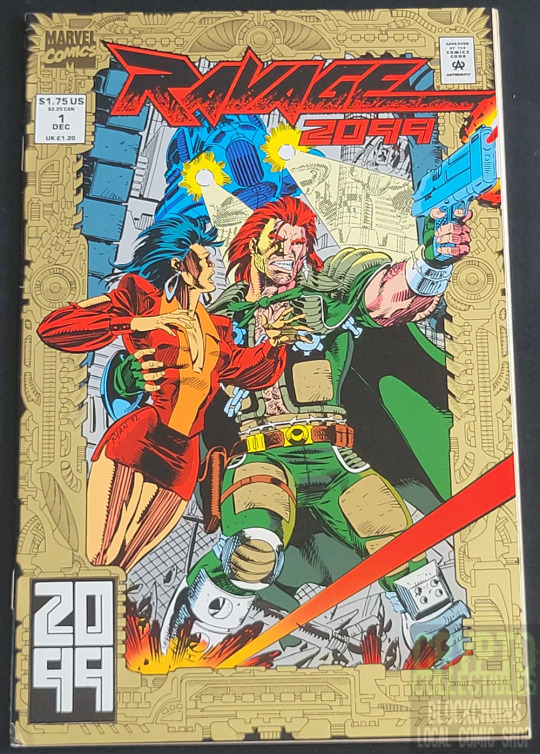

Ravage 2099 #1 (December 1992) by Marvel Comics
Written by Stan Lee, drawn by Paul Ryan, Keith Williams, and by Steve Alexandrov.
#Ravage 2099#Marvel Comics#1992#Paul-Phillip Ravage#Eco Central#Etsy#Vintage Comics#Comic Books#Comics#Paul Rayn#Stan Lee#Keith Williams#Steve Alexandrov#2099
0 notes
Text

Are you anxious about the specter of old age? Do you dread the inevitable ravages of time? Honey, we ALL do! Let’s watch a movie that exacerbates those fears! (To clarify, I mean aging of the female variety! A man ageing is entirely fine, obviously!).
Yes! Join us at Fontaine’s cocktail bar in Dalston on Thursday 21 September when the FREE monthly Lobotomy Room cinema club (devoted to Bad Movies for Bad People) presents ultra-trashy 1960 exploitation movie The Leech Woman! (Tagline: “Her evil jungle-born secret of eternal youth … drained the love and life from every man she trapped!”).
The Leech Woman opens with suave endocrinologist Dr Paul Talbot (hunky Phillip Terry – an ex-husband of Joan Crawford!) bickering with his embittered, haggard and alcoholic older wife June (Coleen Gray, best remembered for co-starring opposite Tyrone Power in disturbing 1947 noir Nightmare Alley). We know June is evil because she’s wearing one of those Cruella de Vil-style fox fur stoles with the heads still attached). They are interrupted by the arrival of Dr Talbot’s mysterious new patient – a shriveled ancient-looking woman called Malla (Estelle Helmsley) who claims to be 150 years old and to know the secret of restoring lost youth – but first they must accompany her back to her ancestral village in Africa. And ominously, Malla hisses to June, “You are the one in my dreams of blood!” What could go wrong? There are voodoo rituals. Human sacrifice. Stock footage of screeching monkeys and hissing snakes. Quicksand. But weirdly, no leeches!
Lobotomy Room Goes to the Movies is the FREE monthly film club devoted to cinematic perversity! Third Thursday night of every month downstairs at Fontaine’s! Numbers are limited, so reserving in advance via Fontaine’s website is essential. Alternatively, phone 07718000546 or email [email protected]. The film starts at 8:30 pm. Doors to the basement Bamboo Lounge open at 8:00 pm. To ensure everyone is seated and cocktails are ordered on time, please arrive by 8:15 pm at the latest. Full info here.
#lobotomy room#lobotomy room film club#lobotomy room club#the leech woman#exploitation movie#horror movie#hagsploitation#kitsch#bad movies we love#bad movies for bad people#bad movies rule#bad taste#shock value
8 notes
·
View notes
Photo


the cover to Sales To Astonish Autumn 1992 by Ty Templeton
#Ty Templeton#Spider-Man 2099#Ravage 2099#Punisher 2099#Doom 2099#Miguel O'Hara#Victor Von Doom#Jake Gallows#Paul-Phillip Ravage
45 notes
·
View notes
Photo

2021 was unremarkable for most people but proved to be another decent year for cinema. Of course there wasn't enough time to see all we wanted or all there was, so these are just the highlights. Hope you get to check them out. 1. Memoria (d. Apitchatpong Weerasethakul
2. Wheel of Fortune and Fantasy (d. Ryusuke Hamaguchi)
3. Mad God (d. Phil Tippett)
4. About Endlessness (d. Roy Andersson)
5. The Village Detective: a song cycle (d. Bill Morrison)
6. Drive My Car (d. Ryusuke Hamaguchi)
7. Taipei Suicide Story (d. KEFF)
8. Annette (d. Leos Carax)
9. North By Current (d. Madsen Minax)
10. We're All Going to the World's Fair (d. Jane Schoenbrun)
11. A Black Rift Begins to Yawn (d. Matthew Wade)
12. All Light, Everywhere (d. Theo Anthony)
13. Licorice Pizza (d. Paul Thomas Anderson)
14. Titane (d. Julia Ducournau);
15. The Souvenir Part II (d. Joanna Hogg)
16. Athanor: The Alchemical Furnace (dirs. Jan Danhel & Adam Olha)
17. Ravaged by the Sun <American Cannibalism> (d. embryoroom)
18. I Was a Simple Man (d. Christopher Makoto Yogi)
19. Woodlands Dark And Days Bewitched: A History Of Folk Horror (d. Kier-La Janisse)
20. The Awakening of Lilith (d. Steven Adam Renkovish)
21. Barber Westchester (d. Jonni Phillips)
22. Bad Luck Banging or Loony Porn (d. Radu Jude)
23. The Tragedy of Macbeth (d. Joel Coen)
24. Short Vacation (d. Han-Sol Seo, Kwon Min-pyo)
25. Benedetta (d. Paul Verhoeven)
26. The Card Counter (d. Paul Schrader)
27. Summer of Soul (d. Questlove)
28. Apples (d. Christos Nikou)
29. Ste. Anne (d. Rhayne Vermette).
#embryoroom #iwasasimpleman #woodlands #jonniphillips #badluckbanging #macbeth #summerofsoul #apples #steanne #nonfilms
#2021#films#best of#memoria#ryusuke hamaguchi#wheel of fortune and fantasy#mad god#phil tippett#about endlessness#roy andersson#the village detective#bill morrison#drive my car#taipei suicide story#keff#annette#leos carax#sparks#north by current#madsen minax#we're all going to the world's fair#jane schoenbrun#a black rift begins to yawn#matthew wade#all light everywhere#theo anthony#licorice pizza#paul thomas anderson#titane#julia ducournau
61 notes
·
View notes
Text

The August 1928 issue of Amazing Stories was where Buck Rogers had his debut in the story Armageddon 2149 by Phillip Francis Nowlan. Originally he was merely Anthony Rogers, a veteran of the Great War (World War I) and employee of the American Radioactive Gas Corporation. While investigating reports of unusual phenomena reported in abandoned coal mines near Wyoming Valley in Pennsylvania, Rogers is exposed to radioactive gas and falls into “a state of suspended animation, free from the ravages of catabolic processes, and without any apparent effect on physical or mental faculties.”

Frank Rudolph Paul was an American illustrator of pulp magazines in the science fiction field. A discovery of editor Hugo Gernsback, Paul was influential in defining the look of both cover art and interior illustrations in the nascent science fiction pulps of the 1920s.
17 notes
·
View notes
Link
Trump’s alt-right MAGA boys: “Build that wall” #TrumpShutdown
The White “Catholic school boys” are from Mitch McConnell’s and Rand Paul’s home state of Kentucky! Home to #NeoConfederate #NeoNazis #kkk

Tribe Elder Nathan Phillips fought in the Vietnam War
Trump dodged fighting in Vietnam FIVE times #BoneSpurs
Mitch McConnell was diagnosed with optic neuritis and was deemed medically unfit for military service
Rand Paul did not and will not serve
Phillips, an Omaha tribe elder who fought in the Vietnam War and now lives in Michigan, has long been active in the indigenous rights movement.
A co-founder of the Native Youth Alliance cultural and education group, he shows up to Arlington National Cemetery every Veteran’s Day with a peace pipe to pay tribute to Native Americans who served in the U.S. military.
“My job has always been taking care of the fire, to keep the prayers going,” Phillips said.
Start of the story
The images in a series of videos that went viral on social media Saturday showed a tense scene near the Lincoln Memorial.
In them, a Native American man steadily beats his drum at the tail end of Friday’s Indigenous Peoples March while singing a song of unity for indigenous people to “be strong” in the face of the ravages of colonialism that now include police brutality, poor access to health care and the ill effects of climate change on reservations. #TakeAKnee
Surrounding him are a throng of young, mostly white teenage boys, several wearing Make America Great Again caps, with one standing about a foot from the drummer’s face also wearing a relentless smirk.
Nathan Phillips, a veteran in the indigenous rights movement, was that man in the middle.
“It was getting ugly, and I was thinking: ‘I’ve got to find myself an exit out of this situation and finish my song at the Lincoln Memorial,’ ” Phillips recalled. “I started going that way, and that guy in the hat stood in my way and we were at an impasse. He just blocked my way and wouldn’t allow me to retreat.”
This is “emblematic of our discourse in Trump’s America”
Some of the teens in the video wore sweatshirts from Covington Catholic High School in Park Hills, Ky., which sent students to Washington to participate in Friday’s antiabortion March for Life event, according to an archived page of the school’s website that was taken down on Saturday.
“To see a group of students from a Catholic school who are practicing such intolerance is a sad sight for me.”, Rep. Deb Halland (D-N.M.)
Covington Catholic High School and the diocese of Covington joint statement
“We condemn the actions of the Covington Catholic High School students towards Nathan Phillips specifically, and Native Americans in general,” the statement said.
Send the tough boy talkers to the Army. Be All You Can Be!
“The matter is being investigated and we will take appropriate action, up to and including expulsion.”
Trump’s Wall is a monument to White Supremacy

#native americans#native american#first peoples#indigenous#indigenous people#nathan phillips#trump base#kentucky#mitch mcconnell#rand paul#covington catholic high school#white supremacy#white supremecists#alt-rght#neo-nazis#trump#donald trump#trump shutdown#trump wall#nowall#police brutality#omaha tribe#washington#lincoln memorial#votevets#veterans#republicans#racism#racism in america#potus
20 notes
·
View notes
Photo








Ravage 2099 #1
Paul-Phillip Ravage had been betrayed by the company he had believed in and was now hunted by the law.
14 notes
·
View notes
Photo

For the week of 4 February 2019
Quick Bits:
Archie #702 sees Sandy Jarrell and Matt Herms pitch in for much of this issue as Betty and Veronica try to figure out who Archie’s seeing now. It goes about as well as you’d expect. Nick Spencer is still delivering some humorous dialogue and the opening sequence from Marguerite Sauvage is as beautiful as ever.
| Published by Archie Comics
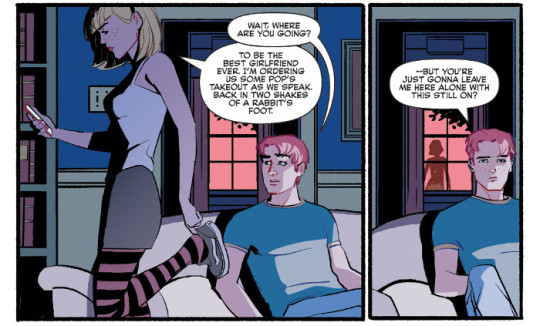
Archie 1941 #5 is pretty heavy, dealing with the the grief, remorse, and emotional devastation of loss experienced during the war. Peter Krause and Kelly Fitzpatrick’s artwork has been wonderful throughout this entire series and they nail the conclusion.
| Published by Archie Comics
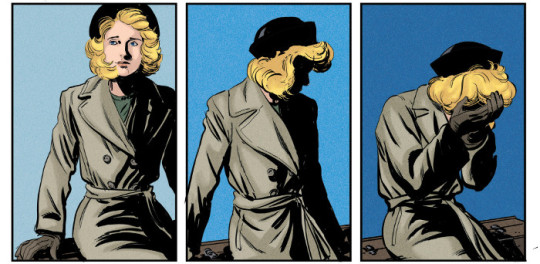
Avengers #14 sparks the fuse of the vampire civil war from Jason Aaron, David Marquez, Justin Ponsor, Erick Arciniega, and Cory Petit. There’s some really nice world-building going on here with the Legion of the Unliving and a rather interesting development with Ghost Rider.
| Published by Marvel
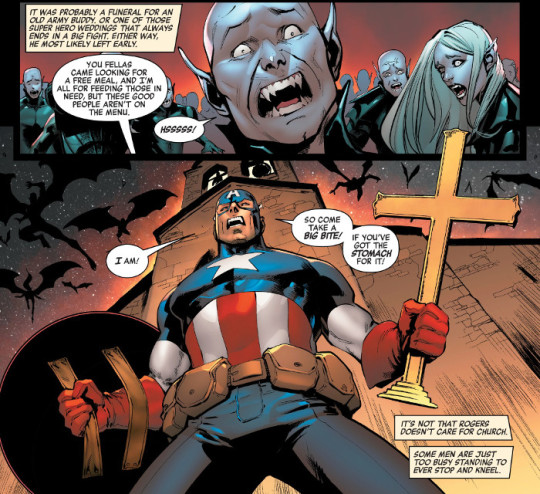
Batman #64 begins “The Price” crossover with The Flash from Joshua Williamson, Guillem March, Tomeu Morey, and Steve Wands. Outside of the tie-ins throughout the DC titles, I haven’t been reading Heroes in Crisis, but this ties in as well, spotlighting some of the strain that Batman and the Flash have been under. Something definitely feels off about the situation.
| Published by DC Comics
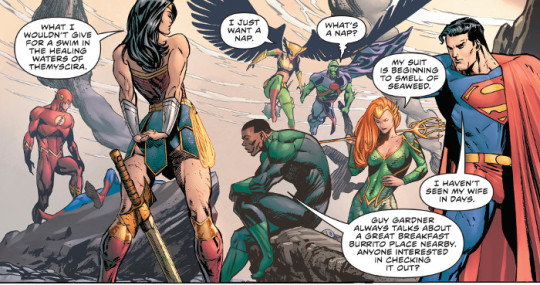
BPRD: The Devil You Know #13 feels like shuffling deck chairs on the Titanic at this point, with all of the pieces moving into place, and we’re just awaiting the inevitable end of everything. Stunning artwork from Laurence Campbell and Dave Stewart.
| Published by Dark Horse
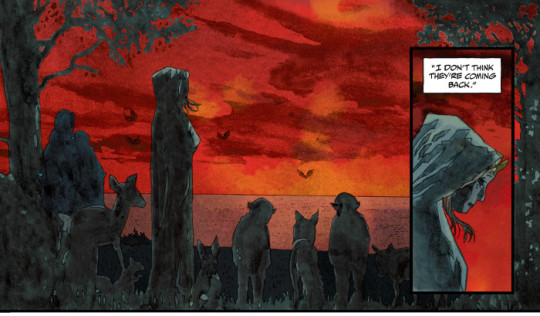
Champions #2 fills in the hole of what happened during the battle with Zzzax last issue and, boy, is it a doozy. Jim Zub, Steven Cummings, Marcio Menyz, and Clayton Cowles set up something interesting, and possibly horrifying, to come down the line.
| Published by Marvel

Conan the Barbarian #3 maintains its high bar of excellence as the one-off stories building up Conan’s past continue from Jason Aaron, Mahmud Asrar, Matthew Wilson, and Travis Lanham. The art from Asrar and Wilson is just perfect.
| Published by Marvel
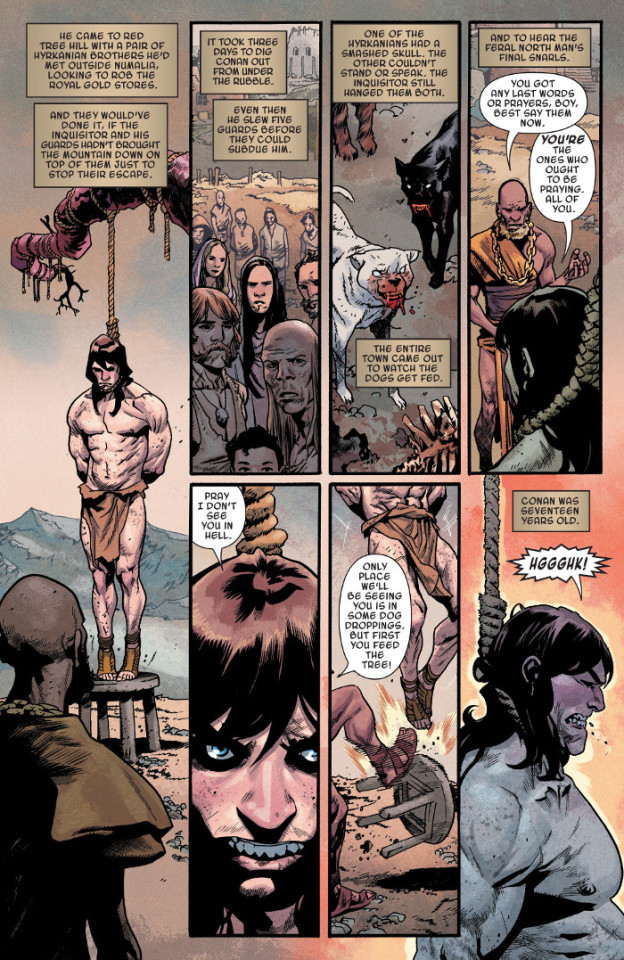
The Curse of Brimstone #11 is the beginning of the end in the first of this two-part finale for the series from Justin Jordan, Denys Cowan, John Stanisci, Rain Beredo, and Wes Abbott. It’s great to see Cowan’s art here as he, Stanisci, and Beredo make the beginning of this final fight look absolutely gorgeous.
| Published by DC Comics

Daredevil #1 is a very impressive debut from Chip Zdarsky, Marco Checchetto, Sunny Gho, and Clayton Cowles. It picks up from Matt’s recovery in Man Without Fear and, well, things are messy, unfocused, and he’s having a hell of a time getting his feet under him again. But, beyond that, there’s a real depth to the story here. Though there’s a ton of action, it also goes deep into character building and flashbacks of Matt’s time as a kid getting morality lessons from his priest. This is damn good, taking cues from Frank Miller and David Mazzucchelli’s “Born Again”, but it also feels influenced by Mike Grell’s “The Longbow Hunters”. There’s also a back-up written and illustrated by Zdarsky himself with an interpretation of how Daredevil “sees” and the digital edition gives a smattering of back-up material including covers, art comparisons, and sketches. I highly recommend this.
| Published by Marvel
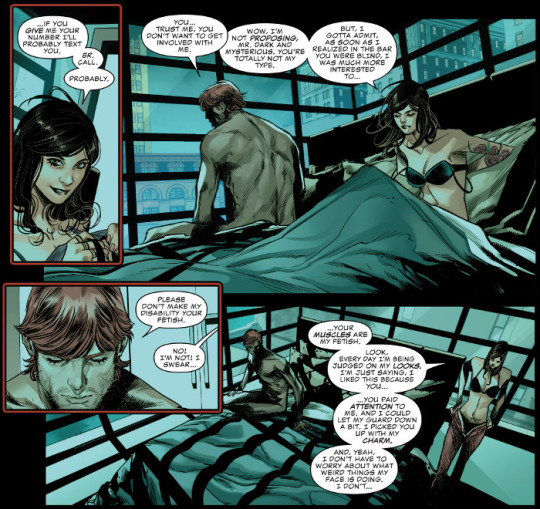
Deathstroke #40 concludes the “Arkham” arc with Slade killing Hugo Strange and then slaughtering a bunch of homeless men. Maybe. Depends on which truth you believe. In doing so, Priest sets up the seeds for the upcoming crossover with Teen Titans.
| Published by DC Comics
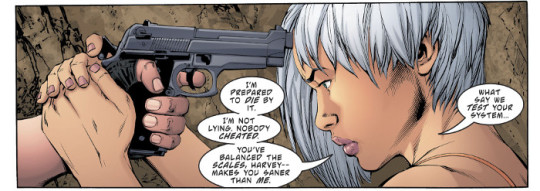
Die #3 peels back another layer of the onion of this world as Kieron Gillen, Stephanie Hans, and Clayton Cowles give us a story of how the various regions work. All through an allegory of war between Eternal Prussia and Little England, Tolkien re-adapted to a kind of explanation on his own allegory. It’s interesting, especially when coupled with the essay Gillen pens in the back that explains the whole construct. That said, it also works great as just an extremely pretty adventure where a party of adventurers fights a dragon. I’m loving what this series is doing.
| Published by Image

Doctor Who: The Thirteenth Doctor #4 concludes the opening arc with the Hoarder from Jody Houser, Rachael Stott, Erica Eren Angiolini, Viviana Spinelli, Richard Starkings, Sarah Jacobs, and John Roshell. I still love the inventiveness and ornate quality to the Hoarder’s design.
| Published by Titan

The Empty Man #4 gives a bit more insight into the disease ravaging the planet, as more of the strange skittering monsters appear and the kids from the original mini-series return. Cullen Bunn, Jesús Hervás, Niko Guardia, and Ed Dukeshire are crafting something very dark and weird with this series, but also very, very good.
| Published by BOOM! Studios
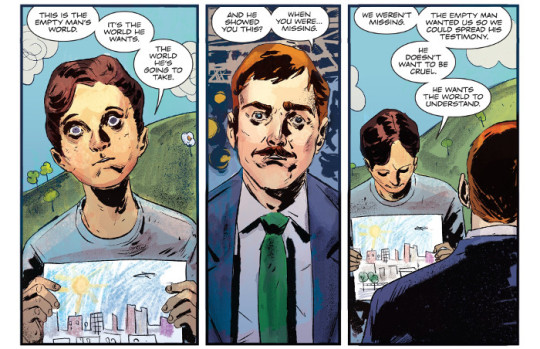
Female Furies #1 isn’t a bad start from Cecil Castellucci, Adrian Melo, Hi-Fi, and Carlos M. Mangual. I quite like Melo’s art here, as she’s adapted it somewhat to highlight influences from some Fourth World luminaries like Jack Kirby, Keith Giffen, and Walt Simonson.
| Published by DC Comics

The Freeze #3 delves deeper into the early days after the Freeze as the awakened look into the serial killings, and we get more mysteries in missing people (who may or may not be the same as those murdered) and the revelation that Ray is being manipulated. Really great work here from Dan Wickline, Phillip Sevy, and Troy Peteri.
| Published by Image / Top Cow
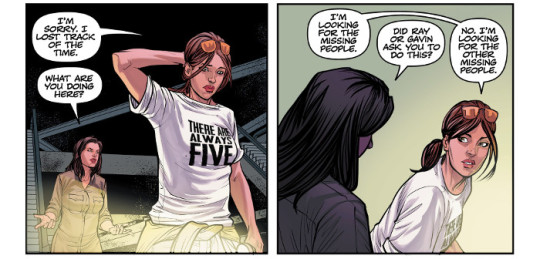
GI Joe: Sierra Muerte #1 sees Michael Fiffe bring his kind of retro charm to the Joes in the beginning of this series. It’s actually played pretty straight and reminds me of the loving care that Tom Scioli also takes to these properties. Great art and a story that reminds me of the original GI Joe cartoon.
| Published by IDW
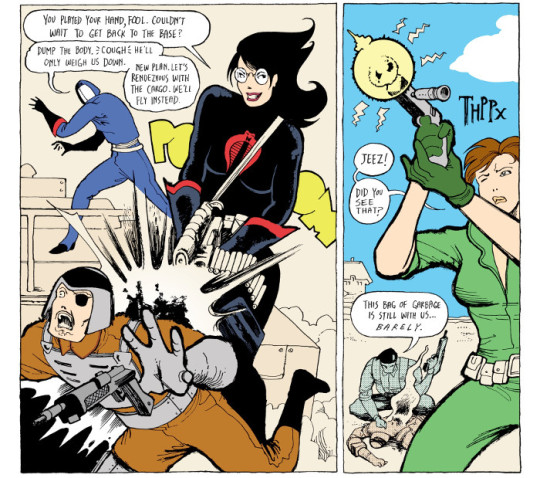
Giant Days #47 intertwines Daisy learning to drive, McGraw’s brother dropping in on him and Susan, and Esther taking care of an illicit adorable puppy. All the usual humour and character building you’d expect from John Allison, Max Sarin, Whitney Cogar, and Jim Campbell.
| Published by Boom Entertainment / BOOM! Box
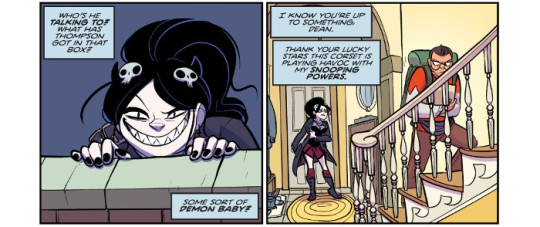
The Girl in the Bay #1 is an intriguing debut from JM DeMatteis, Corin Howell, James Devlin, and Clem Robins. It jumps headlong in to some of DeMatteis’ favourite themes and topics as spiritualism, reincarnation, and coming of age (particularly in Brooklyn) and presents a compelling world and mystery for the seemingly dead, then strangely awakened fifty years later Karen Sartori. Very nice artwork from Howell and Devlin.
| Published by DC Comics / Berger Books

The Green Lantern #4 may yet be the most beautiful issue to date, with Liam Sharp and Steve Oliff elevating the impossibly high bar of their artwork to an even greater level. The character designs, page layouts, panel transitions, and sheer storytelling in the artwork is incredible.
| Published by DC Comics
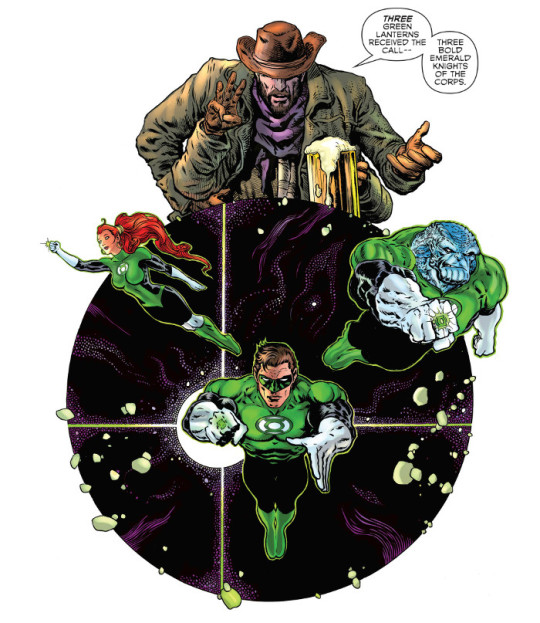
Gunhawks #1 is another of the revived title one-shots in celebration of Marvel’s 80th anniversary, this one a western from David & Maria Lapham, Luca Pizarri, Neeraj Menon, Rachelle Rosenberg, and Travis Lanham. It’s gritty, bloody, and the art from Pizarri, Menon, and Rosenberg is very impressive.
| Published by Marvel
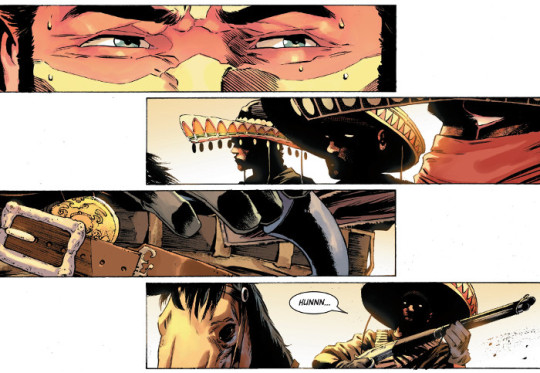
Immortal Hulk #13 concludes the descent into Hell in an issue that is probably as epic as the Avengers beatdown from #7. Al Ewing, Joe Bennett, Ruy José, Belardino Brabo, Rafael Fonteriz, Paul Mounts, and Cory Petit continue to deliver one of the best series on the stands today.
| Published by Marvel
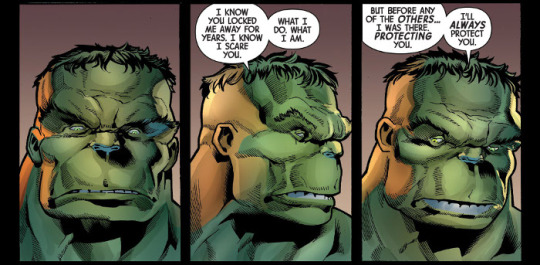
Justice League #17 follows on from the annual and the revelations in the “Escape from Hawkworld” arc in this single issue story of Martian Manhunter’s past from Scott Snyder, Jim Cheung, Mark Morales, Walden Wong, Tomeu Morey, and Tom Napolitano. Some fascinating developments in J’onn’s history here, with gorgeous artwork, and the funny truth that Batman’s really a concerned bat-dad.
| Published by DC Comics

Killmonger #4 wages a pitched battle with Die #3 and The Green Lantern #4 for most beautiful art in a comic this week. Juan Ferreyra’s work is stunning, giving the book depth, character, and an immense re-readability just to stare at the imagery again. There is a wonderful sequence of blood pooling up the page as the violence and body count increases and the design for the cat goddess is gorgeous. As to that latter, Egypt isn’t for want of multiple cat deities and, though Sekhmet is probably the easy answer, I wouldn’t be surprised if this is the older and somewhat lesser known Mafdet. Bryan Hill, Ferreyra, and Joe Sabino continue to deliver one hell of a solid story with this series.
| Published by Marvel
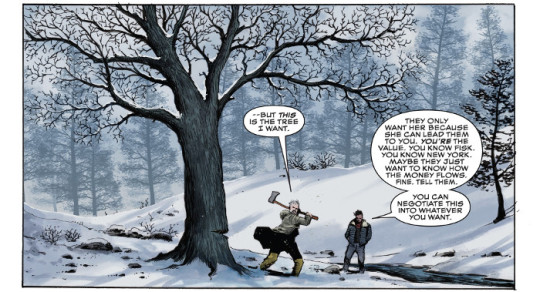
Oberon #1 is off to a fantastic start with this tale from Ryan Parrott, Miloš Slavković, and Charles Pritchett. It strikes a nice balance between fantasy and the mundane as Bonnie finds out she, and the world, aren’t exactly what she thought. Gorgeous artwork from Slavković.
| Published by AfterShock
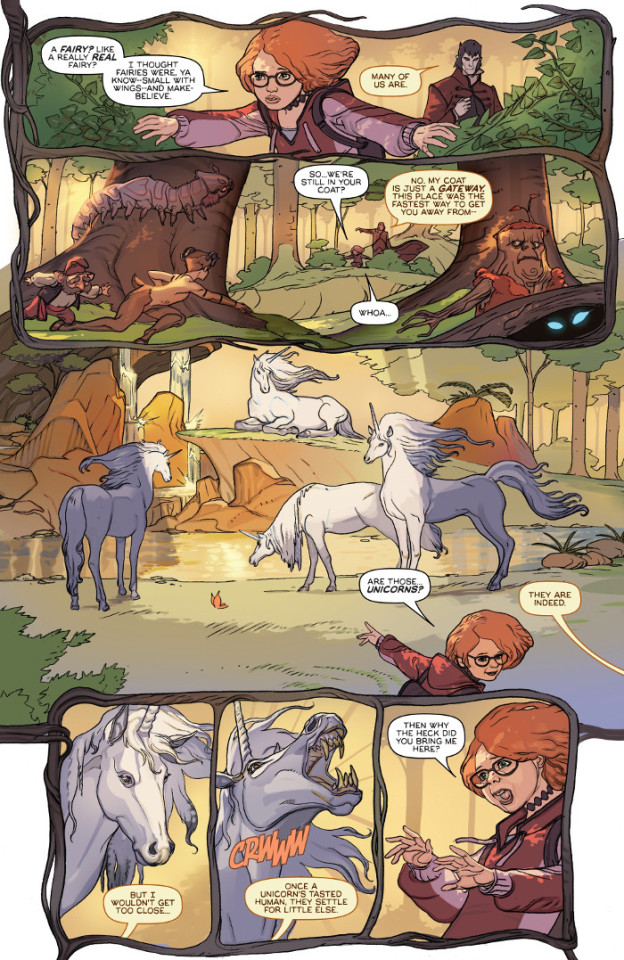
Old Man Quill #1 kicks off a Guardians tale set in the “Old Man” universe from Ethan Sacks, Robert Gill, Andres Mossa, and Joe Caramagna. I liked the recently concluded Sacks-penned Old Man Hawkeye series as well and Star-Lord appears to be taking on that same kind of beaten-down sardonicism of Clint.
| Published by Marvel

Prodigy #3 sees Crane and Agent Straks racing across the globe to find out information on the cult aiding the alternate dimension insurgents. The artwork from Rafael Albuquerque and Marcelo Maiolo continues to be the main attraction, delivering some amazing action sequences.
| Published by Image

Self/Made #3 gives us another twist as Rebecca and Amala attempt to take down Bryce for control of Amala’s code. This story continues to evolve in some very interesting ways, while including some of the toxicity inherent in some game development studios, with some beautiful artwork from Eduardo Ferigato and Marcelo Costa.
| Published by Image
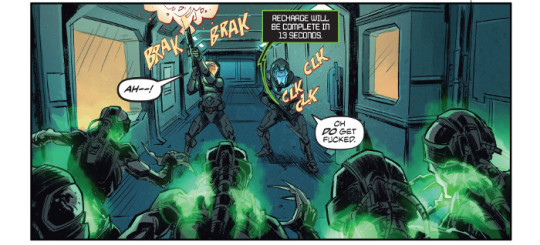
Shadow Roads #6 returns with Brian Hurtt stepping in for the line art and it’s great to see him back illustrating within the Sixth Gun world. Really nice, weird designs for the Bone Plains and interesting hints as to what’s next for the new/old threats seeping back into the world.
| Published by Oni Press
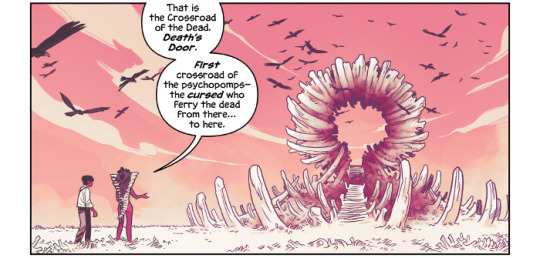
Star Wars: Age of Republic - Anakin Skywalker #1 spotlights a moral quandary for Anakin from Jody Houser, Cory Smith, Wilton Santos, Walden Wong, Java Tartaglia, and Travis Lanham. It’s still interesting to see Anakin as “General Skywalker” during the Clone Wars and how different he was from what he’d become.
| Published by Marvel
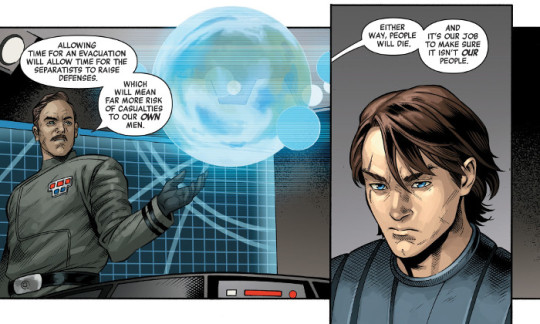
These Savage Shores #3 is almost a perfect comic, actually it may well be a perfect comic. The craft and care that goes into creating this work is astounding. Ram V, Sumit Kumar, Vittorio Astone, and Aditya Bidikar are elevating the art form each issue. With the compelling intertwining of history and horror. With the epistolary narrative approach perfectly befitting the vampire sub-genre. With the attention to detail in how dialogue and narration are presented visually. With the variations on the 9-panel grid to guide pacing and keep the reader visually interested. With the consideration of the colour washes and tones to amplify the mood and atmosphere of the tale. This series is incredible.
| Published by Vault
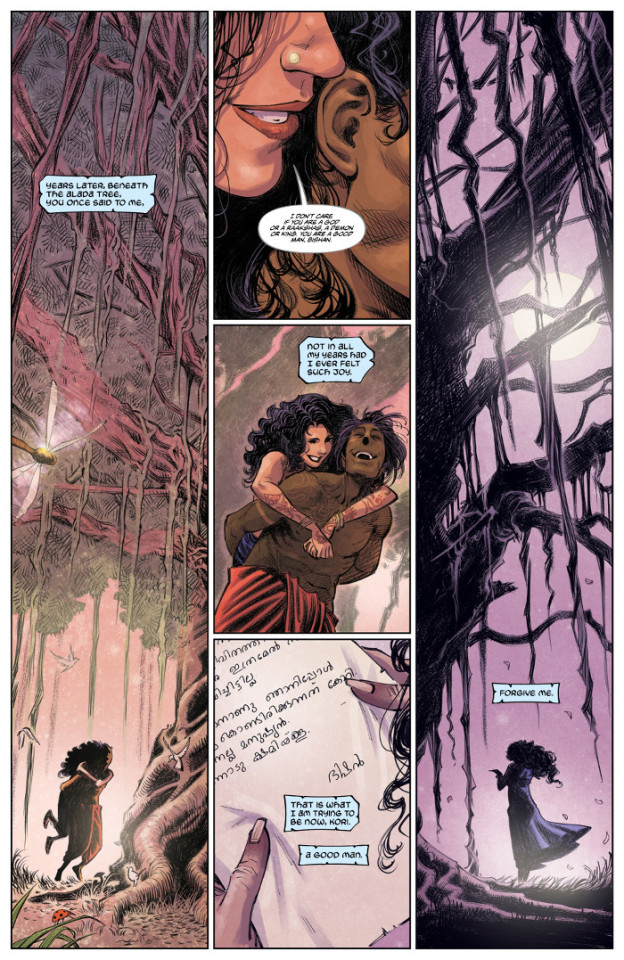
United States vs. Murder Inc. #6 is kind of a weird conclusion to this series as the larger plot of the predicament the families currently find themselves in is left to the next series and, like last issue, we instead get more of Valentine’s family history. Great art, though, from Michael Avon Oeming and Taki Soma. The art really reminds me of some of Darwyn Cooke’s in his Parker adaptations.
| Published by DC Comics / Jinxworld
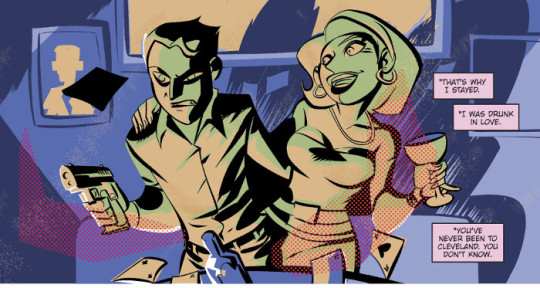
Vindication #1 is an interesting crime drama from MD Marie, Carlos Miko, Dema Jr., Thiago Goncalves, and Troy Peteri. I love the shades of grey and uncertainty in motivation and truth in this story.
| Published by Image / Top Cow
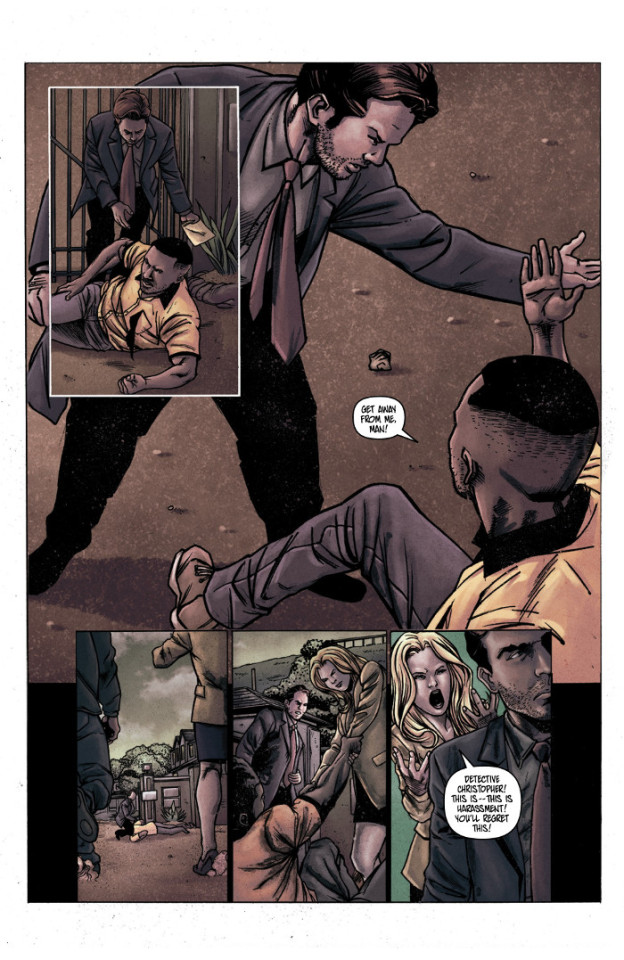
Wasted Space #6 returns with all the humour, violence, and madness that Michael Moreci, Hayden Sherman, Jason Wordie, and Jim Campbell brought to the first arc. I love Sherman’s designs for the gods, they remind me a lot of Ted McKeever’s work.
| Published by Vault
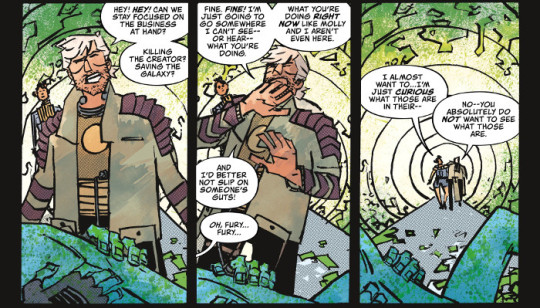
The Wrong Earth #6 ends season one of the series with Dragonfly and Dragonflyman adapting somewhat each to their new Earths, showing a bit of equivocation of the characters as the environment changes them. This has been an interesting story from Tom Peyer, Jamal Igle, Juan Castro, Andy Troy, and Rob Steen and there’s ample threads to bring me back when the series resumes.
| Published by Ahoy

Young Justice #2 continues the adventure in Gemworld in the present, while we get a focus on Wonder Girl in the past. There’s something weird going on here with time and continuity that still feels like a story beat more than Brian Michael Bendis just playing fast and loose with what he wants. Great art from Patrick Gleason, Emanuela Lupacchino, Ray McCarthy, and Alejandro Sanchez.
| Published by DC Comics / Wonder Comics
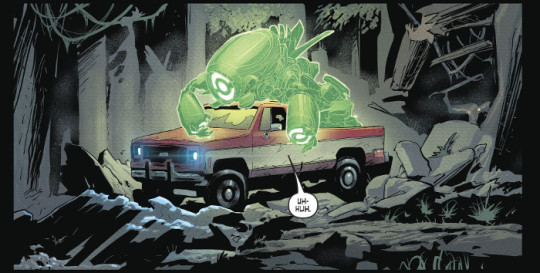
Other Highlights: Asgardians of the Galaxy #6, Atomic Robo & The Dawn of a New Era #2, Battlestar Galactica: Twilight Command #1, Black AF: Devil’s Dye #2, Cemetery Beach #6, Curse Words #20, The Dreaming #6, Feathers, Gasolina #15, GI Joe: A Real American Hero #259, LaGuardia #3, Marvel Action: Avengers #2, Noble #15, Project Superpowers #6, Red Sonja #1, Rise of the Teenage Mutant Ninja Turtles #5, Star Wars #61, Tony Stark: Iron Man #8, The Umbrella Academy: Hotel Oblivion #5, Unnatural #7, Vampirella/Reanimator #2
Recommended Collections: Betrothed - Volume 1: Love or Die, Big Trouble in Little China: Old Man Jack - Volume 3, BPRD: The Devil You Know - Volume 2: Pandemonium, Ether - Volume 2: Copper Golems, Lowlifes, Noble - Volume 3: No One Man, Optimus Prime - Volume 5, TMNT: Bebop & Rocksteady Hit the Road

d. emerson eddy sometimes feels like his old bones should light out for the wastelands.
5 notes
·
View notes
Text
2.11 The Outsider Press Release
MR. GOLD ATTEMPTS TO DISCOVER IF HIS SPELL WILL ALLOW HIM TO CROSS THE STORYBROOKE BORDER AND GO IN SEARCH OF HIS SON, AND BELLE MEETS UP WITHMULAN TO SLAY A FEARSOME YAOGUAI, ON ABC’S “ONCE UPON A TIME”
“The Outsider” - Mr. Gold finds an unwilling test subject to see if a spell he has concocted will allow him to cross the border of Storybrooke – without losing his memory – and go in search of his son, Bae; Belle stumbles upon a vengeful Hook in the Storybrooke harbor whose main goal is to eradicate Rumplestiltskin; and Mary Margaret and David go house hunting in search of a bigger place to live. Meanwhile, in the fairytale land that was, Belle meets Mulan as the two set out to slay a fearsome beast called the Yaoguai, who has been ravaging the land, on “Once Upon a Time,” SUNDAY, JANUARY 13 (8:00-9:00 p.m., ET) on the ABC Television Network.
“Once Upon a Time” stars Ginnifer Goodwin as Snow White/Mary Margaret, Jennifer Morrison as Emma Swan, Lana Parrilla as Evil Queen/Regina, Josh Dallas as Prince Charming/David, Emilie de Ravin as Belle, Jared S. Gilmore as Henry Mills, Meghan Ory as Red Riding Hood/Ruby, and Robert Carlyle as Rumplestiltskin/Mr. Gold.
Guest starring are Raphael Sbarge as Archie Hopper/Jiminy Cricket, Lee Arenberg as Leroy/Grumpy, Tony Amendola as Marco, Keegan Connor Tracy as Mother Superior/Blue Fairy, Colin O'Donoghue as Hook, Beverley Elliott as Granny, Jamie Chung as Mulan, David-Paul Grove as Doc, Faustino Di Bauda as Sleepy, Jeffrey Kaiser as Dopey, Michael Coleman as Happy, Mig Macario as Bashful, Julian Morris as Prince Phillip, Ethan Embry as outsider and Christopher Gauthier as Smee.
“The Outsider” was written by Andrew Chambliss & Ian Goldberg and directed by David Solomon.
5 notes
·
View notes
Text
Cunningham expecting no favours from badly mauled Gloucester
Non-league Football Preview
WITH Gloucester City apparently in free fall, the scene would seem to be set for CURZON ASHTON to pick up their third consecutive National League North win tomorrow (Saturday).
But that's not how manager Steve Cunningham sees it.
Dismissing Gloucester's 9-0 reverse at Chorley as clearly a freak result, he added: "We're in a good place after the 3-0 win at Leamington where we looked comfy, and it's nice to be able to use that word.
"We're showing a bit of consistency and the results are coming but I want to stress that we're not getting excited. Fortunes change and opponents don't come much bigger than Gloucester who were last season's table-toppers.
"They've had a bad start but I'm sure they'll be looking at us and thinking we present them with an opportunity to kick-start their season.
"For my part, I'm hoping the form we've been showing will give them something to think about. I want us to go down there, carry on doing what we've been doing and make some noise against one of the big clubs."
Dale Whitham joins Scott Wilson on Curzon's banned list. Fabien Robert, who was sent off at Chorley, could be missing for Gloucester who released fellow midfielder Josh Thomas earlier this week.
In the wake of the 9-0 defeat, Gloucester captain Kevin Dawson has issued a plea to the fans, asking them to stick by the team. Manager Paukl Groves has issued a statement apologising to fans and promising to recruit the players needed to enhance and improve his injury-ravaged squad.
Having managed a very creditable 1-1 draw at title-favourites South Shields in midweek, ASHTON UNITED find themselves at home to second-placed Buxton in the Pitching-in NPL premier division.
Their upbeat mood should be boosted by the news that manager Mike Clegg at last has a fully fit squad.
Ashton have signed goalkeeper Ollie Martin from Ramsbottom. Casian Anghel has joined Wythenshawe Town on a dual registration.
Fresh from their 2-0 win at Nantwich Town, which will have done a lot to erase the memory of the 6-1 FA Cup thrashing at Morpeth, HYDE UNITED face league leaders South Shields in what will be Jim Gannon's first home match.
However, the new manager has a lengthening injury list to contend with. Tom Morris and Harry Benns are still out, Kyle Brownhill has been ill and James Jones is doubtful with a calf niggle.
"We've been working hard behind the scenes to ensure we have 16 registered for the game," said Gannon.
"The players have trained really well and we're confident we can be competitive and build on Tuesday, although South Shields are clearly going to be a tough test."
Struggling STALYBRIDGE CELTIC embark on a tough run of three away games in a week when they travel to unbeaten Matlock who are managed by former Bower Fold player and boss Paul Phillips.
Simon Haworth's injury woes show no sign of abating. Celtic will definitely be without keeper Grant Shenton (knee), defender Stephen Brogan (hamstring) and midfielder Callum Harris (back). Ethan Padden faces a late fitness test.
New additions the squad are striker Kieran Wells from Frickley, and goalkeeper Louis Hood who has joined on a month's loan from Accrington.
Dave Fish faces some tough choices as he bids to make it three wins on the bounce for his MOSSLEY side who take on Kendal Town at Seel Park in the first division west.
Ben Richardson is ill but five players are away including Dec Evans, David Kuba-Kuba and Connor Morris. However, all the previously injured players have regained fitness.
Fish said: "We're hoping to get a signing through in time for the game so we should still be strong."
GLOSSOP NORTH END, who badly need a win after four consecutive defeats are home to Widnes, the club they beat in the FA Cup on the first day of the season.
Khius Metz is injured but manager Stuart Mellish has signed midfielder Ollie Putnam from Leek and Sam Barratt has resumed training.
Mellish has also taken on former Southend striker Sewah Marah who left Mossley in acrimonious circumstances after only two games.
0 notes
Photo

My Favorite Beverage Is a 2,000-Year-Old Energy Drink From Ancient Rome
The Romans sure knew how to quench their thirst.
Gwynn Guilford
Photo from the Metropolitan Museum of Art/The Elisha Whittelsey Collection, The Elisha Whittelsey Fund, 1949.
We all know it’s good to hydrate. Water can be so blah though. So when I’m trying to rehydrate after a long run in the summer heat, I tend to reach for an old-timey solution: The energy drink of ancient Rome.
The Romans were famed for their innovations in military logistics, which allowed them to extend their territory from Rome and its immediate surrounds to the whole Mediterranean and ultimately, with the establishment of the Roman Empire, virtually all of western Eurasia. But an army can’t win if it’s thirsty. Enter posca. This blend of vinegar and water—and possibly salt, herbs, and other stuff—holds a special place in beverage history thanks to its role as the Gatorade of the Roman army.
It’s possible posca was Greek in origin. Its name may have derived from the Greek word epoxos, which means “very sharp,” according to The Logistics of the Roman Army at War, by Jonathan Roth, historian at San Jose State University. But the beverage owes its fame to the small, but essential, part it played in the Roman army’s legendary efficiency. As early as the middle of the Roman Republic era (509-27 BCE), the military rationed posca to troops along with grains and, very occasionally, meat and cheese. That policy continued for centuries, well into the Roman Empire.
Roman soldiers did, of course, drink water. But historical records suggest that it wasn’t their beverage of choice. Consider what Plutarch wrote about how Cato the Elder, an officer during the Second Punic War (218-202 BCE), dealt with his thirst, according to Roth:
Water was what he drank on his campaigns, except that once in a while, in a raging thirst, he would call for vinegar, or when his strength was failing, would add a little wine.
Like Cato, Romans prized wine for its supposed health benefits, as Rod Phillips, a historian at Carleton University in Ottawa, writes in his book Wine: A Social and Cultural History of the Drink That Changed Our Lives. That made posca—which contained vinegar made from wine gone bad—vastly preferable to plain old H20. And wine, at the time, was plentiful. Rich Romans put back titanic volumes of it. As the reach of Roman imperialism spread throughout Europe, viticulture followed, which “gave their armies ready access to wine depots almost everywhere,” writes Phillips.
For military officials, off wine was a cheap source of calories to distribute in bulk. Diluting it with water to make posca “effectively doubled the volume of liquid ration given to the soldiers at a very low cost,” observes Roth.
There probably was something to the Romans’ belief in posca’s health benefits. The drink’s acidity and slight alcohol content would likely have neutralized bacteria, making it safer than drinking straight water. That could have been a big benefit, given that tainted water has been known to ravage armies more effectively than battle. Vinegar was also thought to help stave off that scourge of militaries throughout history—scurvy. (It doesn’t, as it turns out. But Ancient Romans were hardly the only ones to misplace faith in vinegar’s antiscorbutic virtues; as late as the mid-1800s, the US Army rationed apple cider vinegar to troops stationed in America’s southwest during the Mexican War, according to Roth.)
Mind you, military leaders and other elites generally didn’t deign to drink posca, which was more a drink of the common people, according to Pass the Garum, a fantastic blog dedicated to exploring Roman cuisine. When Roman emperor Hadrian wanted to slum it with his soldiers, this would have been his drink of choice. As Pass the Garum notes, the ancient historian Suetonius mentions vendors selling posca on the streets during the early years of the Roman Empire. Both among soldiers and common folk, posca continued to enjoy favor well into the Middle Ages, writes Andrew Dalby, a renowned historian of Greek and Roman cuisines, in Food in the Ancient World from A to Z.
Aside from slaking Roman thirst, posca’s other main claim to fame arises from its controversial cameo in the Bible. As Jesus Christ was suffering crucifixion—or possibly just before, at Golgotha—Roman soldiers offered him sips of the stuff from a sponge held aloft with a reed, according to Matthew 27:48. Depending on the interpretation, they did this either to help lessen his anguish or to needle him, notes Phillips. Whatever the case, Jesus wasn’t having it. “After tasting the posca, Christ refused to drink it,” writes Phillips. So what did posca taste like? It’s a little hard to say. Due to its ubiquity in Roman literature of the day, we can safely conclude that it involved some ratio of water and red wine vinegar. But might it also have featured other flavors? History isn’t very helpful on that score, since no Roman posca recipes exist.
Thanks to Byzantine medical writers, however, we’re not totally in the dark. Aëtius of Amida and Paul of Aegina, both Byzantine Greek physicians of the sixth and seventh centuries, respectively, included recipes for a “palatable and laxative” posca that included cumin, fennel seed, celery seed, anise, thyme, and salt, according to another book by Dalby, Tastes of Byzantium: The Cuisine of a Legendary Empire. (However, Dalby complicates the matter somewhat by noting that the word they used, the Greek loanword phouska, may by that time have become a catchall term for second-rate wine substitutes.)
Adding herbs and sweeteners push posca in the direction of more familiar old school vinegar-based drinks like switchel, sekanjabin, and shrub. Throw in salt, and you have the combo of carbohydrates and sodium used in Gatorade and other modern sports drinks that help you recover the water and salts lost during exercise (or from simply sweating a lot). That makes sense: tromping around Europe and Asia Minor while saddled with armor and packs was undoubtedly sweaty work.
As for modern-day perspirers, why buy commercial sports drinks to slake your thirst when you can make the Gatorade of the ancients? While the scribes of antiquity haven’t left us a lot to go on, that hasn’t stopped food bloggers and Roman enthusiasts—and me—from trying. For anyone wanting to join in, here are a few recipes and guidelines to get your started. Make sure to use brewed vinegar only—red wine, black, balsamic, or apple cider, for example—and not distilled.
Though we have only the faintest hint that posca was sweetened, lots of recipes call for honey—like ”Sharp-but-sweet Posca” from Pass the Garum:
2 tbsp red wine vinegar
250ml water
1 tbsp honey
According to this recipe, honey should first be melted in the microwave for about 20 seconds, and then added to the water and stirred. Then add the vinegar.
If you want something a little “sharper,” this recipe, from the site Romae Vitam, calls for a much higher proportion of vinegar to water, as well as crushed coriander seeds:
1.5 cups of red wine vinegar
0.5 cups of honey
1 tablespoon of crushed coriander seed
4 cups of water
The recipe calls for boiling the honey and letting it cool before combining. Also, make sure to strain out the crushed coriander before drinking.
My own posca–making is guided not by zeal for ancient Rome, but, rather, because I’m really thirsty. So while my concoction was inspired by what I learned from a lecture on ancient Roman cuisine a few years back, it has since strayed from the more authentic recipes listed above. I’ll still use diluted apple cider vinegar, if it’s handy, but I’ll sometimes go with homemade kombucha. And instead of honey, I prefer a glug of maple syrup (less messy). Also, usually, a little salt. And definitely a ton of ice. I’m not sure if you can still call that posca. But whatever it is, on a hot day, it sure hits the spot.
https://getpocket.com/explore/item/my-favorite-beverage-is-a-2-000-year-old-energy-drink-from-ancient-rome?utm_source=pocket-newtab
0 notes
Link
How Susan Sontag Taught Me to Think
The critic A.O. Scott reflects on the outsize influence Sontag has had on his life as a critic.
By A.O. SCOTT OCT. 8, 2019
“I spent my adolescence in a terrible hurry to read all the books, see all the movies, listen to all the music, look at everything in all the museums. That pursuit required more effort back then, when nothing was streaming and everything had to be hunted down, bought or borrowed. But those changes aren’t what this essay is about. Culturally ravenous young people have always been insufferable and never unusual, even though they tend to invest a lot in being different — in aspiring (or pretending) to something deeper, higher than the common run. Viewed with the chastened hindsight of adulthood, their seriousness shows its ridiculous side, but the longing that drives it is no joke. It’s a hunger not so much for knowledge as for experience of a particular kind. Two kinds, really: the specific experience of encountering a book or work of art and also the future experience, the state of perfectly cultivated being, that awaits you at the end of the search. Once you’ve read everything, then at last you can begin.
2 Furious consumption is often described as indiscriminate, but the point of it is always discrimination. It was on my parents’ bookshelves, amid other emblems of midcentury, middle-class American literary taste and intellectual curiosity, that I found a book with a title that seemed to offer something I desperately needed, even if (or precisely because) it went completely over my head. “Against Interpretation.” No subtitle, no how-to promise or self-help come-on. A 95-cent Dell paperback with a front-cover photograph of the author, Susan Sontag.
There is no doubt that the picture was part of the book’s allure — the angled, dark-eyed gaze, the knowing smile, the bobbed hair and buttoned-up coat — but the charisma of the title shouldn’t be underestimated. It was a statement of opposition, though I couldn’t say what exactly was being opposed. Whatever “interpretation” turned out to be, I was ready to enlist in the fight against it. I still am, even if interpretation, in one form or another, has been the main way I’ve made my living as an adult. It’s not fair to blame Susan Sontag for that, though I do.
3 “Against Interpretation,” a collection of articles from the 1960s reprinted from various journals and magazines, mainly devoted to of-the-moment texts and artifacts (Jean-Paul Sartre’s “Saint Genet,” Jean-Luc Godard’s “Vivre Sa Vie,’’ Jack Smith’s “Flaming Creatures”), modestly presents itself as “case studies for an aesthetic,” a theory of Sontag’s “own sensibility.” Really, though, it is the episodic chronicle of a mind in passionate struggle with the world and itself.
Sontag’s signature is ambivalence. “Against Interpretation” (the essay), which declares that “to interpret is to impoverish, to deplete the world — in order to set up a shadow world of ‘meanings,’ ” is clearly the work of a relentlessly analytical, meaning-driven intelligence. In a little more than 10 pages, she advances an appeal to the ecstasy of surrender rather than the protocols of exegesis, made in unstintingly cerebral terms. Her final, mic-drop declaration — “In place of a hermeneutics we need an erotics of art” — deploys abstraction in the service of carnality.
4 It’s hard for me, after so many years, to account for the impact “Against Interpretation” had on me. It was first published in 1966, the year of my birth, which struck me as terribly portentous. It brought news about books I hadn’t — hadn’t yet! — read and movies I hadn’t heard about and challenged pieties I had only begun to comprehend. It breathed the air of the ’60s, a momentous time I had unforgivably missed.
But I kept reading “Against Interpretation” — following it with “Styles of Radical Will,” “On Photography” and “Under the Sign of Saturn,” books Sontag would later deprecate as “juvenilia” — for something else. For the style, you could say (she wrote an essay called “On Style”). For the voice, I guess, but that’s a tame, trite word. It was because I craved the drama of her ambivalence, the tenacity of her enthusiasm, the sting of her doubt. I read those books because I needed to be with her. Is it too much to say that I was in love with her? Who was she, anyway?
5 Years after I plucked “Against Interpretation” from the living-room shelf, I came across a short story of Sontag’s called “Pilgrimage.” One of the very few overtly autobiographical pieces Sontag ever wrote, this lightly fictionalized memoir, set in Southern California in 1947, recalls an adolescence that I somehow suspect myself of having plagiarized a third of a century later. “I felt I was slumming in my own life,” Sontag writes, gently mocking and also proudly affirming the serious, voracious girl she used to be. The “pilgrimage” in question, undertaken with a friend named Merrill, was to Thomas Mann’s house in Pacific Palisades, where that venerable giant of German Kultur had been incongruously living while in exile from Nazi Germany.
The funniest and truest part of the story is young Susan’s “shame and dread” at the prospect of paying the call. “Oh, Merrill, how could you?” she melodramatically exclaims when she learns he has arranged for a teatime visit to the Mann residence. The second-funniest and truest part of the story is the disappointment Susan tries to fight off in the presence of a literary idol who talks “like a book review.” The encounter makes a charming anecdote with 40 years of hindsight, but it also proves that the youthful instincts were correct. “Why would I want to meet him?” she wondered. “I had his books.”
6 I never met Susan Sontag. Once when I was working late answering phones and manning the fax machine in the offices of The New York Review of Books, I took a message for Robert Silvers, one of the magazine’s editors. “Tell him Susan Sontag called. He’ll know why.” (Because it was his birthday.) Another time I caught a glimpse of her sweeping, swanning, promenading — or maybe just walking — through the galleries of the Frick.
Much later, I was commissioned by this magazine to write a profile of her. She was about to publish “Regarding the Pain of Others,” a sequel and corrective to her 1977 book “On Photography.” The furor she sparked with a few paragraphs written for The New Yorker after the Sept. 11 attacks — words that seemed obnoxiously rational at a time of horror and grief — had not yet died down. I felt I had a lot to say to her, but the one thing I could not bring myself to do was pick up the phone. Mostly I was terrified of disappointment, mine and hers. I didn’t want to fail to impress her; I didn’t want to have to try. The terror of seeking her approval, and the certainty that in spite of my journalistic pose I would be doing just that, were paralyzing. Instead of a profile, I wrote a short text that accompanied a portrait by Chuck Close. I didn’t want to risk knowing her in any way that might undermine or complicate the relationship we already had, which was plenty fraught. I had her books.
7 After Sontag died in 2004, the focus of attention began to drift away from her work and toward her person. Not her life so much as her self, her photographic image, her way of being at home and at parties — anywhere but on the page. Her son, David Rieff, wrote a piercing memoir about his mother’s illness and death. Annie Leibovitz, Sontag’s partner, off and on, from 1989 until her death, released a portfolio of photographs unsparing in their depiction of her cancer-ravaged, 70-year-old body. There were ruminations by Wayne Koestenbaum, Phillip Lopate and Terry Castle about her daunting reputation and the awe, envy and inadequacy she inspired in them. “Sempre Susan,” a short memoir by Sigrid Nunez, who lived with Sontag and Rieff for a while in the 1970s, is the masterpiece of the “I knew Susan” minigenre and a funhouse-mirror companion to Sontag’s own “Pilgrimage.” It’s about what can happen when you really get to know a writer, which is that you lose all sense of what or who it is you really know, including yourself.
8 In 2008, Farrar, Straus & Giroux, Sontag’s longtime publisher, issued “Reborn,” the first of two volumes so far culled from nearly 100 notebooks Sontag filled from early adolescence into late middle age. Because of their fragmentary nature, these journal entries aren’t intimidating in the way her more formal nonfiction prose could be, or abstruse in the manner of most of her pre-1990s fiction. They seem to offer an unobstructed window into her mind, documenting her intellectual anxieties, existential worries and emotional upheavals, along with everyday ephemera that proves to be almost as captivating. Lists of books to be read and films to be seen sit alongside quotations, aphorisms, observations and story ideas. Lovers are tantalizingly represented by a single letter (“I.”; ��H”; “C.”). You wonder if Sontag hoped, if she knew, that you would be reading this someday — the intimate journal as a literary form is a recurring theme in her essays — and you wonder whether that possibility undermines the guilty intimacy of reading these pages or, on the contrary, accounts for it.
9 A new biography by Benjamin Moser — “Sontag: Her Life and Work,” published last month — shrinks Sontag down to life size, even as it also insists on her significance. “What mattered about Susan Sontag was what she symbolized,” he concludes, having studiously documented her love affairs, her petty cruelties and her lapses in personal hygiene.
I must say I find the notion horrifying. A woman whose great accomplishments were writing millions of words and reading who knows how many millions more — no exercise in Sontagiana can fail to mention the 15,000-book library in her Chelsea apartment — has at last been decisively captured by what she called “the image-world,” the counterfeit reality that threatens to destroy our apprehension of the actual world.
You can argue about the philosophical coherence, the political implications or the present-day relevance of this idea (one of the central claims of “On Photography”), but it’s hard to deny that Sontag currently belongs more to images than to words. Maybe it’s inevitable that after Sontag’s death, the literary persona she spent a lifetime constructing — that rigorous, serious, impersonal self — has been peeled away, revealing the person hiding behind the words. The unhappy daughter. The mercurial mother. The variously needy and domineering lover. The loyal, sometimes impossible friend. In the era of prestige TV, we may have lost our appetite for difficult books, but we relish difficult characters, and the biographical Sontag — brave and imperious, insecure and unpredictable — surely fits the bill.
10 “Interpretation,” according to Sontag, “is the revenge of the intellect upon art. Even more. It is the revenge of the intellect upon the world.” And biography, by the same measure, is the revenge of research upon the intellect. The life of the mind is turned into “the life,” a coffin full of rattling facts and spectral suppositions, less an invitation to read or reread than a handy, bulky excuse not to.
The point of this essay, which turns out not to be as simple as I thought it would be, is to resist that tendency. I can’t deny the reality of the image or the symbolic cachet of the name. I don’t want to devalue the ways Sontag serves as a talisman and a culture hero. All I really want to say is that Susan Sontag mattered because of what she wrote.
11 Or maybe I should just say that’s why she matters to me. In “Sempre Susan,” Sigrid Nunez describes Sontag as:
... the opposite of Thomas Bernhard’s comic “possessive thinker,” who feeds on the fantasy that every book or painting or piece of music he loves has been created solely for and belongs solely to him, and whose “art selfishness” makes the thought of anyone else enjoying or appreciating the works of genius he reveres intolerable. She wanted her passions to be shared by all, and to respond with equal intensity to any work she loved was to give her one of her biggest pleasures.
I’m the opposite of that. I don’t like to share my passions, even if the job of movie critic forces me to do it. I cling to an immature (and maybe also a typically male), proprietary investment in the work I care about most. My devotion to Sontag has often felt like a secret. She was never assigned in any course I took in college, and if her name ever came up while I was in graduate school, it was with a certain condescension. She wasn’t a theorist or a scholar but an essayist and a popularizer, and as such a bad fit with the desperate careerism that dominated the academy at the time. In the world of cultural journalism, she’s often dismissed as an egghead and a snob. Not really worth talking about, and so I mostly didn’t talk about her.
12 Nonetheless, I kept reading, with an ambivalence that mirrored hers. Perhaps her most famous essay — certainly among the most controversial — is “Notes on ‘Camp,’ ” which scrutinizes a phenomenon defined by “the spirit of extravagance” with scrupulous sobriety. The inquiry proceeds from mixed feelings — “I am strongly drawn to Camp, and almost as strongly offended by it” — that are heightened rather than resolved, and that curl through the 58 numbered sections of the “Notes” like tendrils in an Art Nouveau print. In writing about a mode of expression that is overwrought, artificial, frivolous and theatrical, Sontag adopts a style that is the antithesis of all those things.
If some kinds of camp represent “a seriousness that fails,” then “Notes on ‘Camp’ ” enacts a seriousness that succeeds. The essay is dedicated to Oscar Wilde, whose most tongue-in-cheek utterances gave voice to his deepest thoughts. Sontag reverses that Wildean current, so that her grave pronouncements sparkle with an almost invisible mischief. The essay is delightful because it seems to betray no sense of fun at all, because its jokes are buried so deep that they are, in effect, secrets.
13 In the chapter of “Against Interpretation” called “Camus’ Notebooks” — originally published in The New York Review of Books — Sontag divides great writers into “husbands” and “lovers,” a sly, sexy updating of older dichotomies (e.g., between Apollonian and Dionysian, Classical and Romantic, paleface and redskin). Albert Camus, at the time beginning his posthumous descent from Nobel laureate and existentialist martyr into the high school curriculum (which is where I found him), is named the “ideal husband of contemporary letters.” It isn’t really a compliment:
Some writers supply the solid virtues of a husband: reliability, intelligibility, generosity, decency. There are other writers in whom one prizes the gifts of a lover, gifts of temperament rather than of moral goodness. Notoriously, women tolerate qualities in a lover — moodiness, selfishness, unreliability, brutality — that they would never countenance in a husband, in return for excitement, an infusion of intense feeling. In the same way, readers put up with unintelligibility, obsessiveness, painful truths, lies, bad grammar — if, in compensation, the writer allows them to savor rare emotions and dangerous sensations.
The sexual politics of this formulation are quite something. Reading is female, writing male. The lady reader exists to be seduced or provided for, ravished or served, by a man who is either a scamp or a solid citizen. Camus, in spite of his movie-star good looks (like Sontag, he photographed well), is condemned to husband status. He’s the guy the reader will settle for, who won’t ask too many questions when she returns from her flings with Kafka, Céline or Gide. He’s also the one who, more than any of them, inspires love.
14 After her marriage to the sociologist Philip Rieff ended in 1959, most of Sontag’s serious romantic relationships were with women. The writers whose company she kept on the page were overwhelmingly male (and almost exclusively European). Except for a short piece about Simone Weil and another about Nathalie Sarraute in “Against Interpretation” and an extensive takedown of Leni Riefenstahl in “Under the Sign of Saturn,” Sontag’s major criticism is all about men.
She herself was kind of a husband. Her writing is conscientious, thorough, patient and useful. Authoritative but not scolding. Rigorous, orderly and lucid even when venturing into landscapes of wildness, disruption and revolt. She begins her inquiry into “The Pornographic Imagination” with the warning that “No one should undertake a discussion of pornography before acknowledging the pornographies — there are at least three — and before pledging to take them on one at a time.”
The extravagant, self-subverting seriousness of this sentence makes it a perfect camp gesture. There is also something kinky about the setting of rules and procedures, an implied scenario of transgression and punishment that is unmistakably erotic. Should I be ashamed of myself for thinking that? Of course! Humiliation is one of the most intense and pleasurable effects of Sontag’s masterful prose. She’s the one in charge.
15 But the rules of the game don’t simply dictate silence or obedience on the reader’s part. What sustains the bond — the bondage, if you’ll allow it — is its volatility. The dominant party is always vulnerable, the submissive party always capable of rebellion, resistance or outright refusal.
I often read her work in a spirit of defiance, of disobedience, as if hoping to provoke a reaction. For a while, I thought she was wrong about everything. “Against Interpretation” was a sentimental and self-defeating polemic against criticism, the very thing she had taught me to believe in. “On Photography” was a sentimental defense of a shopworn aesthetic ideology wrapped around a superstitious horror at technology. And who cared about Elias Canetti and Walter Benjamin anyway? Or about E.M. Cioran or Antonin Artaud or any of the other Euro-weirdos in her pantheon?
Not me! And yet. ... Over the years I’ve purchased at least three copies of “Under the Sign of Saturn” — if pressed to choose a favorite Sontag volume, I’d pick that one — and in each the essay on Canetti, “Mind as Passion,” is the most dog-eared. Why? Not so I could recommend it to someone eager to learn about the first native Bulgarian to win the Nobel Prize for Literature, because I’ve never met such a person. “Mind as Passion” is the best thing I’ve ever read about the emotional dynamics of literary admiration, about the way a great writer “teaches us how to breathe,” about how readerly surrender is a form of self-creation.
16 In a very few cases, the people Sontag wrote about were people she knew: Roland Barthes and Paul Goodman, for example, whose deaths inspired brief appreciations reprinted in “Under the Sign of Saturn.” Even in those elegies, the primary intimacy recorded is the one between writer and reader, and the reader — who is also, of course, a writer — is commemorating and pursuing a form of knowledge that lies somewhere between the cerebral and the biblical.
Because the intimacy is extended to Sontag’s reader, the love story becomes an implicit ménage à trois. Each essay enacts the effort — the dialectic of struggle, doubt, ecstasy and letdown — to know another writer, and to make you know him, too. And, more deeply though also more discreetly, to know her.
17 The version of this essay that I least want to write — the one that keeps pushing against my resistance to it — is the one that uses Sontag as a cudgel against the intellectual deficiencies and the deficient intellectuals of the present. It’s almost comically easy to plot a vector of decline from then to now. Why aren’t the kids reading Canetti? Why don’t trade publishers print collections of essays about European writers and avant-garde filmmakers? Sontag herself was not immune to such laments. In 1995, she mourned the death of cinema. In 1996, she worried that “the very idea of the serious (and the honorable) seems quaint, ‘unrealistic’ to most people.”
Worse, there are ideas and assumptions abroad in the digital land that look like debased, parodic versions of positions she staked out half a century ago. The “new sensibility” she heralded in the ’60s, “dedicated both to an excruciating seriousness and to fun and wit and nostalgia,” survives in the form of a frantic, algorithm-fueled eclecticism. The popular meme admonishing critics and other designated haters to shut up and “let people enjoy things” looks like an emoji-friendly update of “Against Interpretation,” with “enjoy things” a safer formulation than Sontag’s “erotics of art.”
That isn’t what she meant, any more than her prickly, nuanced “Notes on ‘Camp’ ” had much to do with the Instagram-ready insouciance of this year’s Met Gala, which borrowed the title for its theme. And speaking of the ’Gram, its ascendance seems to confirm the direst prophecies of “On Photography,” which saw the unchecked spread of visual media as a kind of ecological catastrophe for human consciousness.
18 In other ways, the Sontag of the ’60s and ’70s can strike current sensibilities as problematic or outlandish. She wrote almost exclusively about white men. She believed in fixed hierarchies and absolute standards. She wrote at daunting length with the kind of unapologetic erudition that makes people feel bad. Even at her most polemical, she never trafficked in contrarian hot takes. Her name will never be the answer to the standard, time-killing social-media query “What classic writer would be awesome on Twitter?” The tl;dr of any Sontag essay could only be every word of it.
Sontag was a queer, Jewish woman writer who disdained the rhetoric of identity. She was diffident about disclosing her sexuality. Moser criticizes her for not coming out in the worst years of the AIDS epidemic, when doing so might have been a powerful political statement. The political statements that she did make tended to get her into trouble. In 1966, she wrote that “the white race is the cancer of human history.” In 1982, in a speech at Town Hall in Manhattan, she called communism “fascism with a human face.” After Sept. 11, she cautioned against letting emotion cloud political judgment. “Let’s by all means grieve together, but let’s not be stupid together.”
That doesn’t sound so unreasonable now, but the bulk of Sontag’s writing served no overt or implicit ideological agenda. Her agenda — a list of problems to be tackled rather than a roster of positions to be taken — was stubbornly aesthetic. And that may be the most unfashionable, the most shocking, the most infuriating thing about her.
19 Right now, at what can feel like a time of moral and political emergency, we cling to sentimental bromides about the importance of art. We treat it as an escape, a balm, a vague set of values that exist beyond the ugliness and venality of the market and the state. Or we look to art for affirmation of our pieties and prejudices. It splits the difference between resistance and complicity.
Sontag was also aware of living in emergency conditions, in a world menaced by violence, environmental disaster, political polarization and corruption. But the art she valued most didn’t soothe the anguish of modern life so much as refract and magnify its agonies. She didn’t read — or go to movies, plays, museums or dance performances — to retreat from that world but to bring herself closer to it. What art does, she says again and again, is confront the nature of human consciousness at a time of historical crisis, to unmake and redefine its own terms and procedures. It confers a solemn obligation: “From now to the end of consciousness, we are stuck with the task of defending art.”
20 “Consciousness” is one of her keywords, and she uses it in a way that may have an odd ring to 21st-century ears. It’s sometimes invoked now, in a weak sense, as a synonym for the moral awareness of injustice. Its status as a philosophical problem, meanwhile, has been diminished by the rise of cognitive science, which subordinates the mysteries of the human mind to the chemical and physical operations of the brain.
But consciousness as Sontag understands it has hardly vanished, because it names a phenomenon that belongs — in ways that escape scientific analysis — to both the individual and the species. Consciousness inheres in a single person’s private, incommunicable experience, but it also lives in groups, in cultures and populations and historical epochs. Its closest synonym is thought, which similarly dwells both within the walls of a solitary skull and out in the collective sphere.
If Sontag’s great theme was consciousness, her great achievement was as a thinker. Usually that label is reserved for theorists and system-builders — Hannah Arendt, Jean-Paul Sartre, Sigmund Freud — but Sontag doesn’t quite belong in that company. Instead, she wrote in a way that dramatized how thinking happens. The essays are exciting not just because of the ideas they impart but because you feel within them the rhythms and pulsations of a living intelligence; they bring you as close to another person as it is possible to be.
21 “Under the Sign of Saturn” opens in a “tiny room in Paris” where she has been living for the previous year — “small bare quarters” that answer “some need to strip down, to close off for a while, to make a new start with as little as possible to fall back on.” Even though, according to Sigrid Nunez, Sontag preferred to have other people around her when she was working, I tend to picture her in the solitude of that Paris room, which I suppose is a kind of physical manifestation, a symbol, of her solitary consciousness. A consciousness that was animated by the products of other minds, just as mine is activated by hers. If she’s alone in there, I can claim the privilege of being her only company.
Which is a fantasy, of course. She has had better readers, and I have loved other writers. The metaphors of marriage and possession, of pleasure and power, can be carried only so far. There is no real harm in reading casually, promiscuously, abusively or selfishly. The page is a safe space; every word is a safe word. Your lover might be my husband.
It’s only reading. By which I mean: It’s everything.”
1 note
·
View note
Text
Blu-ray Review: The Phantasm Collection
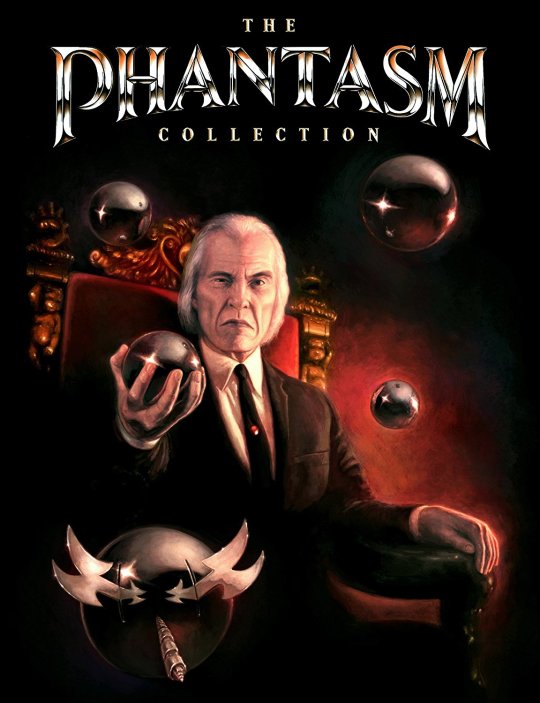
It was long thought impossible for a box set of the Phantasm films to be released in the US due to the rights being controlled by different entities, but Well Go USA has made it happen. Going above and beyond beautiful high-definition transfers of all five films, the six-disc set also contains an exhaustive amount of special features, both new and archival, plus a book and a poster.
Phantasm's most memorable elements - a sinister undertaker who sometimes takes the form of a beautiful woman, flying metallic spheres that suck the blood out of victims’ heads, cloaked dwarfs seemingly plucked out of Star Wars, yellow blood that resembles cheese sauce - sound more like scenes from a nightmare than a movie. In many ways, that’s exactly what the 1979 film is: a hypnagogic fever dream put on screen.
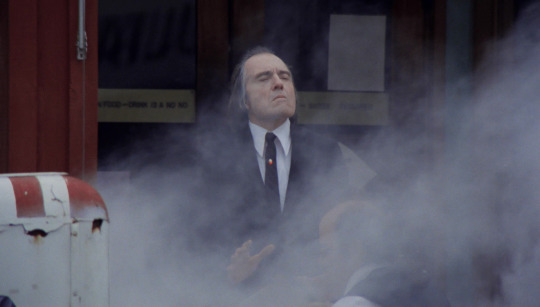
Not only was it a remarkable achievement for an independent film upon its initial release, but Phantasm has also aged surprisingly well after nearly 40 years. Written and directed by Don Coscarelli (The Beastmaster, Bubba Ho-Tep), the surreal plot centers around a boy, Mike Pearson (A. Michael Baldwin), his older brother-turned-guardian, Jody (Bill Thornbury), and their friendly neighborhood ice cream man, Reggie (Reggie Bannister), as they investigate a mysterious mortician known as The Tall Man (Angus Scrimm).
It’s rare to see a scary scene set in the bright sunlight, but that famous slow motion shot of The Tall Man walking through the ice cream truck's fog is positively chilling. Paul Pepperman’s practical effects are realistic enough to induce cringing, from the gory demise of the sphere’s first victim to the lifelike severed fingers. Fred Myrow and Malcolm Seagrave’s oft-repeated theme music never loses its power. The amateur acting is a tad hammy in spots, but the movie also features some truly great character moments, none better than Jody and Reggie jamming on their guitars together.
Phantasm has received a flawless 4K restoration and 5.1 surround sound mix from the original elements by Bad Robot, under the supervision of Coscarelli and noted fan J.J. Abrams (Star Wars: The Force Awakens). The movie has always had a unique, grainy texture that added to the dreamlike quality. Thankfully, the high-definition remaster retains the organic look while bringing new clarity and vividness to the picture.
Well Go updates last year's Phantasm Blu-ray with a new audio commentary by Coscarelli, co-producer Paul Pepperman, and visual consultant Roberto Quezada. Other special features include a commentary by Coscarelli, Baldwin, Thornbury, and Scrimm; a segment from the show Graveyard Carz in which Coscarelli and Baldwin inspect a tribute to the Phantasm ‘Cuda; a vintage TV interview with Coscarelli and Scrimm; deleted scenes; a plethora of behind-the-scenes home movies (some featuring commentary by Coscarelli and Bannister); interview outtakes; footage of Scrimm from a panel at a 1989 Fangoria convention; a Fangoria commercial starring Scrimm from 1988; a still gallery; TV and radio spots; and two trailers.
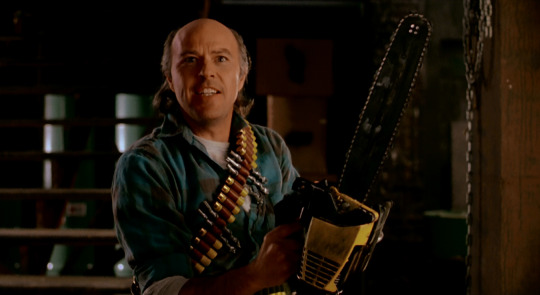
1988's Phantasm II begins the franchise's tradition of sequels picking up immediately where the previous installment left off. In this case, Coscarelli shows us what Reggie is up to downstairs while Mike is attacked by the Tall Man upstairs. It then cuts to six years later, when Mike (now played by James Le Gros, Point Break) is released from the mental institution where he's been held since the events of the first film.
Mike and Reggie hit the road together on the hunt for the Tall Man. They evade hits traps along the way, in addition to developing respective love interests. Mike dreams of Liz (Paula Irvine), a girl who also lives in fear of The Tall Man. Reggie, ever the lady's man, works his magic on a hitchhiker named Alchemy (Samantha Phillips). He also constructs a quad-barrel shotgun, which joins his 'Cuda as a signature of the character and the franchise.
Coscarelli intended to have Baldwin reprise his role as Mike alongside the other returning cast members, but Universal Pictures, who produced the film, insisted a working actor be cast in the lead role. Le Gros does a fine job in the inherited part, but the transition feels jarring when watching the franchise back-to-back. The surreal elements are slightly subdued, likely at the studio's behest as well, but they are still very present in the form of the nightmarish visions that plague Mike.
The trade-off was worthwhile, however, as Phantasm II has the largest budget of the series with $3 million. All the elements that made the first Phantasm so successful are present, but the bigger budget affords a larger scale with more gore and action. Gooey practical effects and rubber monsters - designed by Mark Shostrom (Evil Dead II, A Nightmare on Elm Street 3: Dream Warriors) with the assistance of fellow special effects greats Greg Nicotero and Robert Kurtzman - give the picture a distinct '80s horror feel.
Unlike the other discs in the box set, Phantasm II is licensed from Scream Factory, so the company's Collector's Edition release from 2013 is repackaged. There aren't any new special features, but the disc was already stacked: a 46-minute making-of featurette with the cast and crew; a featurette on the special effects; an audio commentary with Coscarelli, Bannister, and Scrimm; deleted scenes; alternate and extended workprint scenes; behind-the-scenes footage from the set; an educational short film produced by Encyclopedia Britannica starring a young Scrimm as Abraham Lincoln; three still galleries; TV spots; and trailers.
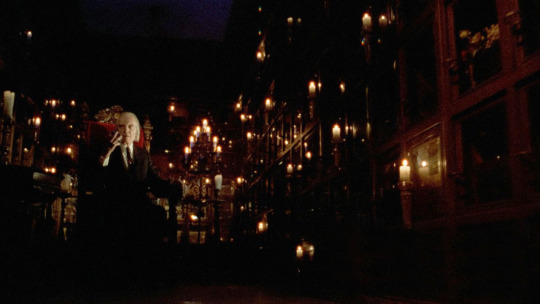
1994's Phantasm III: Lord of the Dead was made for about half the budget of the previous installment, which allowed Coscarelli to have more creative freedom. As a result, the surreal elements are back in the forefront. More noteworthy, Baldwin returns to his rightful role as Mike. The transition between actors is pulled off seamlessly with a clever switcheroo in editing between a recap of the previous film and current events.
While Mike was the star of the show last time around, Reggie takes the lead on this one. Previously playing more of a sidekick, he gleefully assumes the role of the action hero in spite of his humble beginnings as a bald, middle-aged ice cream man. Mike is largely absent for the film's midsection as we follow Reggie's adventures to save him and defeat the Tall Man. The focus on Reggie results in more comedic relief, which borders between fun and out of place.
En route, Reggie befriends Tim (Kevin Connors), a child sidekick who mirrors Mike in the original film, and Rocky (Gloria Lynne Henry), a badass, nunchuk-wielding army chick. Jody also makes his return to the story, trapped in one of the Tall Man's spheres. Speaking of which, the sphere effects were perfected by visual effects creator Kerry Prior in this film; they look better here than any other Phantasm movie.
The budget may have been lower, but not debilitatingly so. Shostrom was brought back for more creative practical effects, which include zombie-like creatures on the hunt for Reggie and the gang. Phantasm III also boasts one of the wildest car stunts ever put on celluloid, as fearless stuntman Bob Ivy launches a pink hearse off a pipe ramp at a high speed, hurling the vehicle much farther than anticipated. It's quite a sight to behold, particularly in high definition.
New special features for Phantasm III: Lord of the Dead include: a 48-minute making-of featurette with the cast and crew; a featurette dedicated to Ivy's aforementioned death-defying stunt; a commentary by Coscarelli and editor Norman Buckley; and a new compilation of behind-the-scenes footage from the set. Archival extras include: a charming commentary by Baldwin and Scrimm; an earlier, shorter collection of on-set footage; a deleted scene; a still gallery; a radio spot; and the trailer.
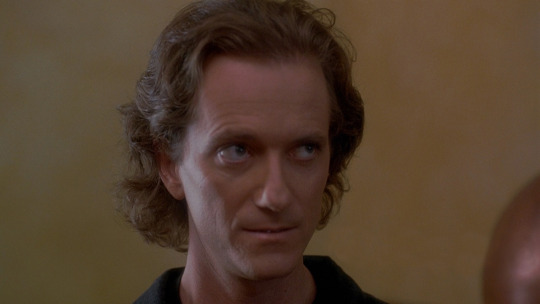
1998's Phantasm IV: Oblivion returns the franchise to its ambitious independent roots. It was long thought to be the end of the series - and, although it pales in comparison to earlier entries, it offers a gratifying conclusion. Due to the decreased budget, Coscarelli relies on the performances to deliver an engaging story rather than the spectacle of action and special effects - although there are some of those as well, including KNB EFX helping out on a couple notable effects.
As you might expect, the film is a bit more esoteric than the prior installments. The spirit of Jody urges Reggie to find Mike and help him on his quest to stop the Tall Man once and for all. The old friends embark on an interdimensional journey, expanding the series' rich mythology even further. Insight is given on the Tall Man's human backstory, which had been previously unexplored.
What makes Oblivion particularly fascinating is that it repurposes unused footage from the original Phantasm, working it in as flashbacks and visions. It might come off as a cheap gimmick in most films, but it feels genuine here, given that all the actors are still involved, not to mention the franchise's tendency for thinking outside the box. It helps that the footage is quite interesting, like the scene in which Mike and Jody hang the Tall Man.
New special features for Phantasm IV: Oblivion include: a 47-minute making-of featurette with the cast and crew; a compilation of behind-the-scenes footage from the set; and a gallery of Justin Zaharczuk's concept art. Previously existing extras include: a commentary with Coscarelli, Bannister, and Scrimm; behind-the-scenes footage (which is essentially a truncated cut of the new version); a gallery of behind-the-scenes stills; and two trailers.
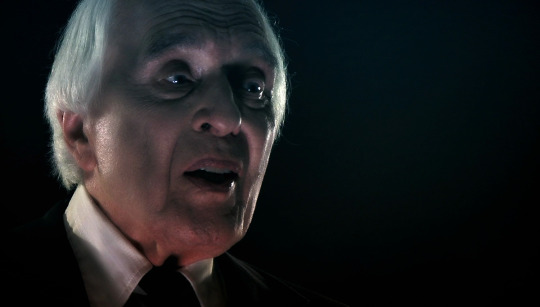
2016's Phantasm: Ravager is the only Phantasm film not to be directed by Coscarelli. He passes the torch to David Hartman, though he worked closely as a co-writer and producer. It marks the live-action feature debut of Hartman, who has a long history in animation. He also serves as cinematographer, editor and visual effects artist on the film, among other duties. Although he has crafted many memorable moments throughout the years, Coscarelli’s direction has always been fairly straightforward, so the changing of the guard isn’t particularly noticeable.
The plot shifts between three timelines centering around Reggie, and neither the viewer nor the character knows for sure which is real. In one, he’s the same Reggie that fans know and love; on the road searching for his old friend, Mike. In another, he’s in a nursing home suffering from early onset dementia. In the third, he’s been in a comatose state since the events of Oblivion, and now he’s awakened to find that The Tall Man rules the earth.
It’s very much Reggie’s movie, and Bannister’s enthusiasm to revisit his iconic role translates on screen. Baldwin also plays a big role as Mike, and Thornbury joins in later as Jody. The Tall Man pops up intermittently, per usual, but he has meatier dialogue than in past films, and Scrimm nails it. Kathy Lester briefly reprises her role the Lady in Lavender from the original, and Henry makes her triumphant return as Rocky in a post-credit scene. Stephen Jutras is immediately likable as Chunk, a little person with a big personality.
Ravager feels like a fan film at times, but Hartman’s appreciation for the franchise is apparent. It suffers from its prolonged production that began as a web series with no clear end game in sight. Its seams are particularly apparent in the early portion of the film, which plays out like a series of vignettes. Thankfully, the story largely coalesces before the credits roll. Along the way, the story ties up some loose ends left by past installments while introducing new ideas, characters, and questions.
There are a few solid practical effects, but the film relies too heavily on digital effects. Several are decent for a low budget movie, while others are distractingly bad. CGI is the only way to pull off several of the ambitious concepts - like the giant spheres - but the amateurish effects resemble something found in a Syfy movie. Although imperfect, Ravager ultimately brings the storied franchise to a satisfying close, complete with everything that made the original Phantasm so memorable.
Well Go obviously held back a few extras from last year's physical release of the film to include in the box set version: a fun 50-minute montage of footage, photos, visual effects tests, and artwork used in the making of the film; video interviews with Baldwin, Lester, and Jutras; and the end credit montage sans credits. The previous extras are also present: an informative commentary by Hartman and Coscarelli; a behind-the-scenes featurette; three deleted scenes (including one with a giant dwarf played by Friday the 13th's Derek Mears) with optional commentary; an amusing collection of bloopers and outtakes; and the teaser and trailer.
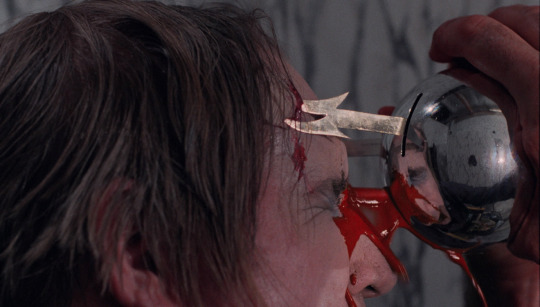
A bonus disc collects even more supplementary materials: Phantasmagoria, a 2005 feature-length documentary about the franchise directed by Jake West (Doghouse); Phantasm & You, Hartman's satirical recap of the franchise styled after 1950s public service announcements; full panel discussions from Flashback Weekend Chicago 2008, Flashback Weekend Chicago 2014, and Fantastic Fest 2016; a live performance of an original song about the Lady in Lavender by Lester, whose sultry voice suits her character; a tour of Phantam's shooting locations hosted by Bannister; Phantasm Genesis, a behind-the-scenes look at some of the effects in Oblivion; and Phandom, an 18-mnute piece dedicated to the franchise's rabid fanbase.
And that's not all! The set also comes with Phantasm Compendium, a 120-page book written by Ben Wan, which chronicles the history and impact of the franchise. It features exclusive interviews with cast and crew members, accompanied by behind-the-scenes photos. Lastly, the package contains a 21x27 reversible poster, with The Dude Designs' new box set artwork on one side and Aaron Lea's stunning Phantasm: Remastered poster on the other.
Arrow Videos is releasing its own Phantasm box set in the UK, which may have superior packaging (it comes in a sphere replica), but it's impossible to compete with Well Go's exhaustive amount of special features. It's evident upon diving into them how passionate Coscarelli and the actors remain about the material and the fans after all these years.
Phantasm is easily one of the most fascinating franchises to marathon through. Each film could have served as an ending to the series, yet the subsequent sequel always picks up right were the previous one left off. Not only is it a treat to watch the same characters and cast members grow and mature as the mythology expands, but Coscarelli's creative force continuously propels the story in unexpected directions.
The Phantasm Collection is available now via Well Go USA.
#phantasm#phantasm ravager#phantasm remastered#phantasm: ravager#phantasm: remastered#angus scrimm#well go usa#review#article
35 notes
·
View notes
Text
Chapter 5: Ravage 2099 #2
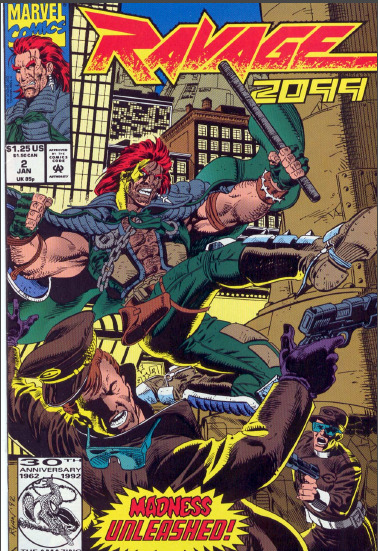
Previously Paul-Phillip Ravage is a naive idiot straight out of a Silver Age comic who lost his job and reputation because he believes that Alchemax is NOT a corrupt company. Now he is the Garbage Avenger: a Brooklyn sounding anarchist who dress up in trash and drives a garbage truck. Not really a good first impression IMO.
The comic opens up with this ugly mofo!

Y’know I kind of want to give the artist prop for making this Mutroid look like the many characters that only Jack Kirby would draw. And yes the dialogue didn’t improve . . . okay they slightly improve but now we have to deal with Silver Age style text boxes that always opens up the story.
Anyway Stormer wants to overthrow Dethstryk rule over Hellrock, and doesn’t take shit from anyone who disagrees with him.
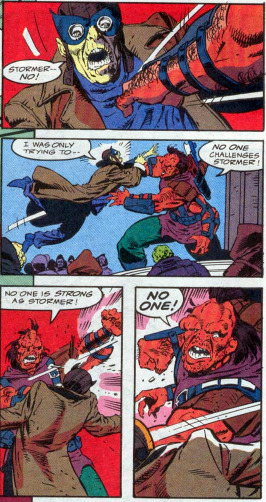
Getting tired of shit, Dethstryk decided to come down from his plaza and deal with the rabble rouser who thinks he’s tough shit . . . does anybody use rabble rouser anymore?

Stormer attacks Dethstryke but comes to realize he was no match.

youtube
So yeah Stormer realizes he’s no match for Dethstryk and surrenders like the bitch he is.
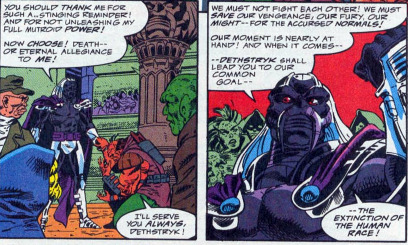
He is totally an original character! Clearly he isn’t a rip off to Doctor Doom and Magneto given the last panel!
But enough about him, let’s get to the main story where a bunch of cops talk shit about Ravage’s truck.

Being the law abiding individual as painfully seen in the last comic, Ravage decided to ram his truck at the law enforcement . . . oh right, I forgot he became a loose cannon rebel at the end of the first comic.
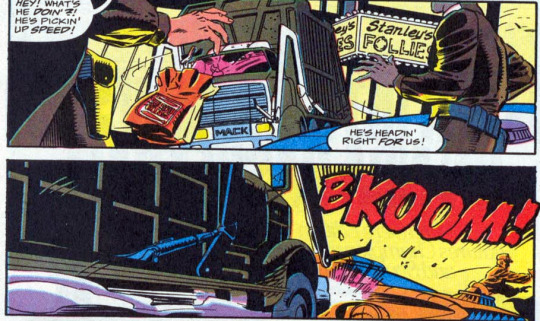
I like to think the reason why he is attacking the officers is because he didn’t take to kindly about what they said about his truck.
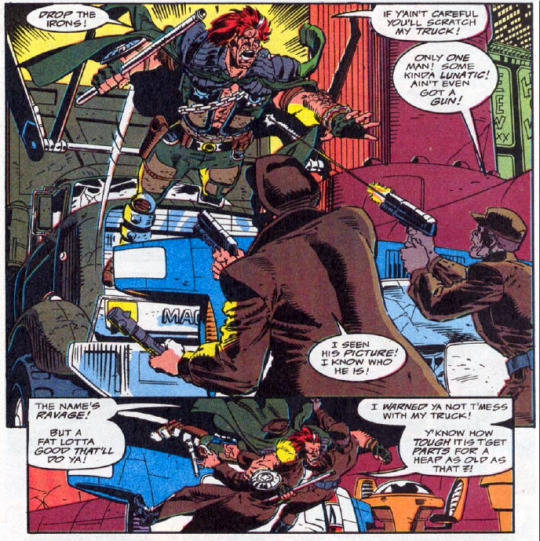
Holy crap, I was just joking about his reasons for attacking the officers. But judging by his dialogue, his truck is serious fucking business.
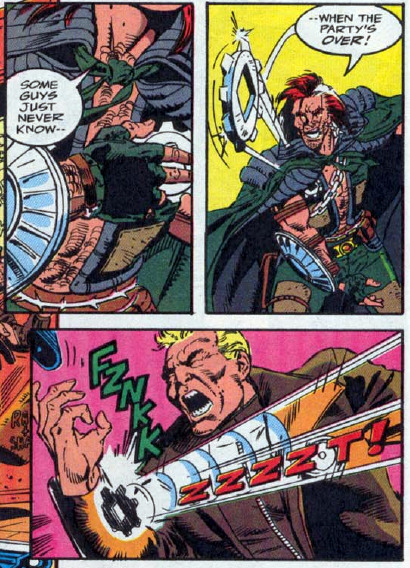
And the Garbage Avenger threw a cog at the Public Eye officer like it was a Batarang. Dear God, this story is actually picking up! Why wasn’t THIS the first comic instead of that lame out dated bullshit that is the actual Ravage 2099 #1.
Seriously, I think I prefer Ravage as the Garbage Avenger more than him as some CEO to cop hippies. It actually shows how the character live up to his name. Especially in his monologue lampshading how much of a pushover he was for Alchemax.

While driving his truck he notice an ad for the Ultimate Kevlar, which is some sort of blasterproof cloth. Knowing how useful that would be, he does like any liked minded American and loot the place with his TRUKK!
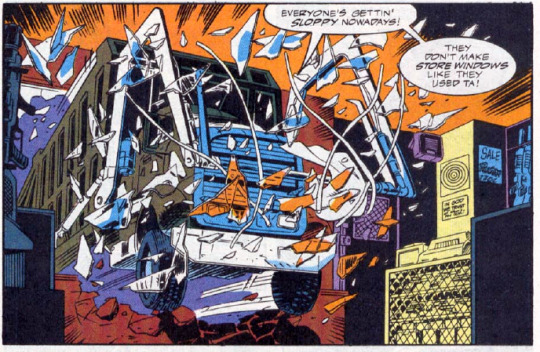
Our hero ladies and gentleman . . . though granted he is stealing it from an obviously corrupt corporation and he is basically the Stone Cold Steve Austin of the story. So I’ll let it slide. Too bad Public Eye won’t as they give chase to the Garbage Avenger after receiving reports of breaking and entering..
But the question still remains: is the Ultimate Kevlar really blaster proof?

Yes. Yes it is.

I don’t think anybody with a sense of fashion would want to wear something that has a “Ravage Seal of Approval”.
Meanwhile Andethrope meets with an officer reporting on his failure to detain Ravage. Mook execution in 4 . . . 3 . . . 2 . . .

Good to see that he’s still acting like a cliche Bond villain.
Meanwhile on Hellrock, Dethstryke receives a premonition of Ravage being a threat to his rule from his soothe sayer.
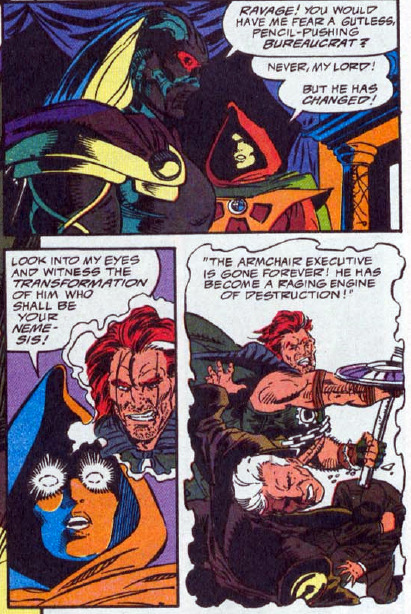
Guess he didn’t heard the news that Ravage is now the Garbage Avenger. Who speaking of is at a dump figuring out a way to hide his truck. Not because he is a fugitive and is identified driving the thing. But really is because in the future it is taboo for Humans to have romantic relationship with Vehicles. And since the love between Ravage and his trukk is publicly known, they are marked for being heathens for even

Aw. He really knows how to sweet talk a gir- I mean trukk. Trukk’s gender is trukk btw. Can’t be misgendering trukk.
Too bad he’s not the only one who has a truck fetish. A bunch of vagrants ambushed Ravage so they can have their way with his trukk!
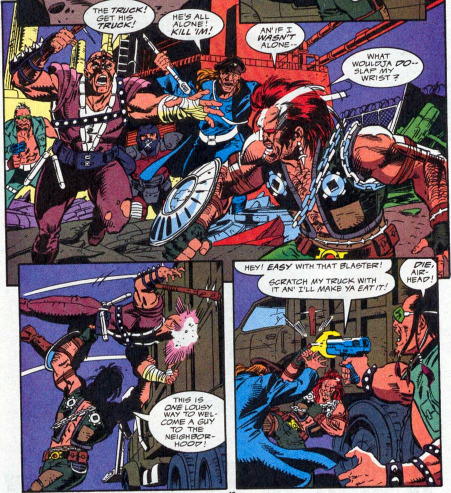
Yeah don’t you dare try to rape his trukk! If anybody is going to fuck it, it’s gonna be Ravage!
I’ll just skip ahead and tell you that he kicked all their asses.

Meanwhile (again) Dethstryk contacts Anderthrope over Ravage still being alive and demands the Bond Villain to lure him to Hellrock.

Oh my God! He’s going to kidnap Ravage’s one true love: HIS TRUKK!!!
. . . Or that hot secretary or whatever. She’s not a trukk. She’s just some model sized Asian lady in a mini skirt and open chest. How can she compete with a trukk!
Anyway, Tiana isn’t happy with Ravage keeping her locked up in the apartment for her protection and notes how she is totally over him. We all know you are jealous of trukk, admit it.
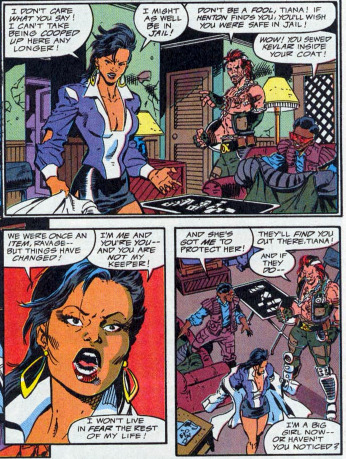
Just as she walks out the door, they are ambushed by Alchemax mercenaries/Public Eye officers (couldn’t tell the difference but I assumed Public Eye are under Alchemax payroll). All of the sudden, Ravage was justified in telling a woman to stay in her place.

Naturally a fight scene occurs . . . nuff said.

Knowing Stan Lee’s way of writing action girls back in the 60s, she’s not going to be of much use.
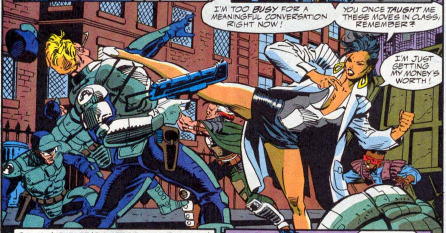
Well I’ll be damned. Guess Stan’s is channeling the way he wrote actions girls like Spider-Woman and She Hulk during the 70s. She’s an actual badass and not completely useless. Wish I could say the same for Dack . . .

You’re black and fighting, who I assume, are future cops. You DON’T have the type advantage here.
Realizing they are getting their asses beat, the Alchemax cops decided to use their transit beam to capture Tiana.
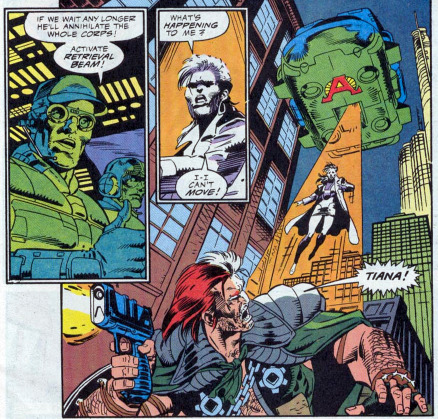
In hindsight, they should of done that to begin with. The comic ends with Ravage swearing to save Tiana and the Alchemax goons revealing where they are heading.

This comic is definitely an improvement over the last one. Don’t get me wrong, it still have it share of flaws including the Hellrock scenes feeling disjointed from the main story, the Silver Age Style still persisting in the writing via dialogue, and not much story development as to why pollution is such a big deal in the future and what use is it for the Mutroids. But I do enjoy it for the shift in the main character’s personality who kind of reminds me of Stone Cold Steve Austin at this point. Seriously, it manage to turn this story around for me as a no nonsense rebel who will fuck up anything and anyone who gets in his/her way is always an awesome yet destructive archetype to see. Not to mention Tiana’s character evolution as she doesn’t act to dependent on Ravage like she did in the first issue and calls him out on his over protection; hope this doesn’t go away. All in all, it’s a better introduction to the series than the first issue.
Next time: Doom 2099 #1. And now I need to change my pants due to all this love nectar in it.
3 notes
·
View notes
Text
My Year In Movies
This isn’t the way I wanted to do this, but a baby has taken over the office and I don’t have much time to sit at my computer, so here’s my list of movies I watched last year. Bold indicates a strong recommendation.
1. The Man From Nowhere (2010) -- Lee Jewon-beom (S. Korea) 2. Immortals (2011) -- Tarsem Singh (USA) 3. Killer Joe (2011) -- William Friedkin (USA) 4. World's Greatest Dad (2009) -- Bobcat Goldthwait (USA) 5. Fanny Hill (1983) -- Gerry O'Hara (UK) 6. I Vitelloni (1953) -- Frederico Fellini (Italy) 7. Inspector Clouseau (1968) -- Bud Yorkin (USA) 8. Bone Tomahawk (2015) -- S. Craig Zahler (USA) 9. Crank: High Voltage (2009) -- Neveldine and Taylor (USA) 10. Love Exposure (2008) -- Shion Sono (Japan) 11. Topkapi (1964) -- Jules Dassin (USA) 12. La Bete Humaine (1938) -- Jean Renoir (France) 13. Harakiri (1962) -- Masaki Kobayashi (Japan) 14. Stir Crazy (1980) -- Sidney Poitier (USA) 15. Mesrine: Public Enemy #1 (2008) -- Jean-Francois Richet (France) 16. Fright Night (1985) -- Tom Holland (USA) -- 35mm in theater, rewatch 17. The Driver (1978) -- Walter Hill (USA) 18. Confessions of a Dangerous Mind (2002) -- George Clooney (USA) 19. 50/50 (2011) -- Jonathan Levine (USA) 20. The Revenant (2015) -- Alejandro G. Inarritu (USA) -- in theater 21. Nausicaa of the Valley of the Wind (1984) -- Hayao Miyazaki (Japan) 22. Broken Arrow (1950) -- Delmer Daves (USA) 23. The Untouchables (1987) -- Brian de Palma (USA) 24. The Key (1983) -- Tinto Brass (Italy) 25. The Big Short (2015) -- Adam McKay (USA) -- in theater 26. The Interview (2014) -- Evan Goldberg and Seth Rogen (USA) 27. Storytelling (2001) -- Todd Solondz 28. Bonfire of the Vanities (1990) -- Brian de Palma (USA) 29. Black Sea (2014) -- Kevin Macdonald (UK/US) 30. The Witch (2015) -- Robert Eggers (US) -- in theater 31. The Rum Diary (2011) -- Bruce Robinson (USA) 32. The Bingo Long Traveling All-Stars & Motor Kings (1976) -- John Badham (USA) 33. The Palm Beach Story (1942) -- Preston Sturges (USA) 34. Shaun the Sheep (2015) -- Mark Burton and Richard Starzak (UK) 35. The Five Obstructions (2003) -- Jorgen Leth and Lars von Trier 36. Quay des Orfevres (1947) -- Henri-Georges Clouzot (France) 37. Hail, Caeser! (2016) -- Coen Bros (US) -- in theater 38. Valley Girl (1983) -- Martha Coolidge (US) 39. Tie Me Up! Tie Me Down! (1989) -- Pedro Almodovar (Spain) 40. Hello, My Name Is Doris (2015) -- Michael Showalter (US) -- in theater 41. To Live and Die In L.A. (1985) -- William Friedkin (US) 42. In Cold Blood (1967) -- Richard Brooks (US) 43. Mr. Toad's Wild Ride (1996) -- Terry Jones (UK) 44. The Deep (1977) -- Peter Yates (US) 45. The Muppet Movie (1979) -- James Frawley (US/UK) -- rewatch 46. Monkey Business (1952) -- Howard Hawks (US) 47. Casablanca (1942) -- Michael Curtiz (US) -- rewatch 48. The Disorderly Orderly (1964) -- Frank Tashlin (US) 49. Destry Rides Again (1939) -- George Marshall (US) 50. Green Fish (1997) -- Lee Chang-dong (S. Korea) 51. Bernie (2011) -- Richard Linklater (US) 52. Easy A (2010) -- Will Gluck (US) 53. The Overnight (2015) -- Patrick Brice (US) 54. 10 Cloverfield Lane (2016) -- Dan Trachtenberg (US) -- in theater 55. Breaking the Waves (1996) -- Lars von Trier (various) 56. Cheap Thrills (2013) -- E.L. Katz (US) 57. Green Room (2016) -- Jeremy Saulnier (US) -- in theater 58. Indiscreet (1958) -- Stanley Donen (US) 59. Conan the Destroyer (1984) -- Richard Fleischer (US) 60. Faust (1926) -- F.W. Murnau (Ger) 61. Belladonna of Sadness (1973) -- Elichi Yamamoto (Japan) -- in theater 62. The Lobster (2015) -- Yorgos Lanthimos (Various) -- in theater 63. The Willies (1990) -- Brian Peck (US) 64. Sympathy for the Devil (2015) -- Neil Edwards (various) -- in theater 65. The Conjuring 2 (2016) -- James Wan (US) -- in theater 66. The Martian (2015) -- Ridley Scott (US) 67. I Love You, Phillip Morris (2009) -- Glenn Ficarra, John Requa (US) 68. Dancer in the Dark (2000) -- Lars von Trier (various) 69. Tickled (2016) -- David Farrier, Dylan Reeve (NZ) -- in theater 70. Hot Lead & Cold Feet (1978) -- Robert Butler (US) 71. De Palma (2015) -- Noah Baumbach, Jake Paltrow (US) -- in theater 72. Little Shop of Horrors (1986) -- Frank Oz (US) 73. Drive Angry (2011) -- Patrick Lussier (US) 74. Death Race 2000 (1975) -- Paul Bartel (US) -- 16mm in theater, rewatch 75. The Endless Summer (1966) -- Bruce Brown (US) 76. Barbarella (1968) -- Roger Vadim (Fr/It) 77. Bugsy Malone (1976) -- Alan Parker (UK) 78. Hunt for the Wilderpeople (2016) -- Taika Waititi (NZ) -- in theater 79. Mission Impossible: Rogue Nation (2015) -- Christopher McQuarrie (US) 80. The Invitation (2015) -- Karyn Kusama (US) 81. The Comedian (1957) -- John Frankenheimer (US) 82. Man Up (2015) -- Ben Palmer (UK) 83. Open Season: Scared Silly (2015) -- David Feiss (US) 84. The Good DInosaur (2015) -- Peter Sohn (US) 85. Burying the Ex (2014) -- Joe Dante (US) 86. Never Take Candy from a Stranger (1960) -- Cyril Frankel (UK) 87. These Are the Damned (1962) -- Joseph Losey (UK) 88. Lo and Behold: Reveries of the Connected World (2016) -- Werner Herzog (US) -- in theater 89. Mission to Mars (2000) -- Brian de Palma (US) 90. Kubo and the Two Strings (2016) -- Travis Knight (US) -- in theater 91. Hell or High Water (2016) -- David Mackenzie (US) -- in theater 92. Russian Ark (2002) -- Alexander Sokurov (RUS) -- didn't finish, too dull 93. Cache (2005) -- Michael Haneke (various) 94. Kull The Conqueror (1997) -- John Nocolella (US) 95. The Witch (2015) -- Robert Eggers (US) -- rewatch 96. River of No Return (1954) -- Otto Preminger (US) 97. Carnal Knowledge (1971) -- Mike Nichols (US) 98. The Final Girls (2015) -- Todd Strauss-Schulson (US) 99. Jamaica Inn (1939) -- Alfred Hitchcock (UK) 100. All the Boys Love Mandy Lane (2006) -- Jonathan Levine (US) 101. Creep (2014) -- Patrick Brice (US) 102. Killer Nun (1979) -- Giulio Berruti (It) 103. Alone in the Dark (1982) -- Jack Sholder (US) 104. Two Evil Eyes (1990) -- George Romero, Dario Argento (US, It) 105. Darling (2015) -- Mickey Keating (US) 106. The Bay (2012) -- Barry Levinson (US) 107. Phantasm: Ravager (2016) -- David Hartman (US) -- in theater 108. We Are Still Here (2015) -- Ted Geoghegan (US) 109. Final Girl (2015) -- Tyler Shields (US) 110. The Nude Vampire (1970) -- Jean Rollin (Fr) 111. Shock (1977) -- Mario Bava (It) 112. The Perfect Host (2010) -- Nick Tomnay (US) 113. Diary of a Madman (1963) -- Reginald Le Borg (US) 114. The Man Who Could Cheat Death (1959) -- Terence Fisher (UK) 115. Zoombies (2016) -- Glenn R. Miller (US) 116. Bedlam (1946) -- Mark Robson (US) 117. Isle of the Dead (1945) -- Mark Robson (US) 118. Brain Damage (1988) -- Frank Henelotter (US) 119. Bound to Vengeance (2015) -- J.M. Craviato (US) 120. Stoker (2013) -- Park Chan-wook (US) 121. Fright Night (2011) -- Craig Gillespie (US) 122. Beneath (2013) -- Larry Fessenden (US) 123. She-Wolf of London (1946) -- Jean Yarbrough (US) 124. Werewolf of London (1935) -- Stuart Walker 125. The Beast from 20,000 Fathoms (1953) -- Eugene Lourie (US) 126. Shutter Island (2010) -- Martin Scorcese (US) 127. Witchboard (1986) -- Kevin Tenney (US) 128. A Bucket of Blood (1959) -- Roger Corman (US) 129. Cannibal Ferox (1981) -- Umberto Lenzi (It) 130. Bloody Mama (1970) -- Roger Corman (US) 131. Goosebumps (2015) -- Rob Letterman (US) 132. The Killing Car (1993) -- Jean Rollin (Fr) 133. The Handmaiden (2016) -- Park Chan-wook (Kor) -- in theater 134. The Most Dangerous Game (1932) -- Irving Pichel and Ernest B. Shoedsack (US) 135. Night Creatures (1962) -- Peter Graham Scott (UK) 136. Moonlight (2016) -- Barry Jenkins (US) -- in theater 137. The Evil of Frankenstein (1964) -- Freddie Frances (UK) 138. Arrival (2016) -- Denis Villeneuve (US) -- in theater 139. Bride of Re-Animator (1989) -- Brian Yuzna (US) 140. Ghostbusters (2016) -- Paul Feig (US) 141. From a Whisper to a Scream (1987) -- Jeff Burr (US) 142. I, Madman (1989) -- Tibor Takacs (US)
2 notes
·
View notes
Text
The Rise of the Alt Right
On August 12, 2017, Heather Heyer was killed in a terrorist attack in Charlottesville, Virginia. A man drove his car through a crowd of counter-protestors, injuring 19 and killing one. Heather was there protesting the Unite the Right rally, a white supremacist rally organized by Jason Kessler and Richard Spencer that took place on August 11 and 12. Kessler and Spencer said that the rally was to protest the removal of a confederate statue of Robert E. Lee from Lee Park, as well as to unite the various white supremacist and alt-right groups in the area. The man who drove his car through the crowd of counter-protestors later plead guilty to 29 federal crimes and is now serving life in prison. This rally, among other events in the past few years, has been a catalyst for the rise of the alt-right. The alt-right, or the alternative right, is a term that originated from Richard Spencer, a white supremacist and neo-Nazi, who gained fame during the 2016 presidential campaign after democratic candidate Hillary Clinton made the claim that Donald Trump’s campaign was driven by “an emerging racist ideology known as the alt-right” (qtd. in Wood). The Anti-Defamation League describes the alt-right as “an extremely loose movement, made up of different strands of people connected to white supremacy.” This begs the question of what has led to the rise of this ideology over the past two years. The rise of the alt-right should be blamed on Donald Trump, because he continues to offer support to white supremacists and leaders of the alt-right movement, as well as supporting legislation that furthers white supremacist ideologies.
In his third statement about the Unite the Right rally in Charlottesville, Virginia, Donald Trump boldly made the claim that there were “very fine people on both sides” of the rally. He also complained about what he called the “very, very violent...alt-left.” The use of the term alt-left here is in particular interest, due to the fact that unlike the term alt-right, the term alt-left was not coined by the group he claims it represents. Richard Spencer, a white supremacist, claimed the term alt-right, and proudly calls himself it. When Donald Trump announced he was running for president Spencer gave his full support. When Trump won the presidential election, Richard Spencer said at a rally, “hail Trump! Hail our people! Hail victory!” (qtd. in Goldstein). Hail victory is the English translation of the exclamation “Sieg Heil,” a phrase used in Nazi Germany often. During his presidential campaign, Donald Trump would often claim that he didn’t know who David Duke, the former grand wizard of the Ku Klux Klan was. This is demonstrably false, however, as in 2000, when he decided to end his run for candidacy, he released a statement saying “the Reform Party now includes a Klansman, Mr. Duke, a neo-Nazi, Mr. Buchanan, and a communist, Ms. Fulani. This is not company I wish to keep” (qtd. in Nagourney). So why is it that when questioned about Duke’s support in 2016, he claimed to not know who he was? Furthermore, in Donald Trump’s State of the Union Address, he said the phrase, “Americans are dreamers too” (qtd. in Osborne). The phrase is a clear reference to the DREAMers movement, a movement that seeks to provide aid to undocumented immigrants, as well as supporting laws improving immigration rights for non-US citizens. The phrase garnered praise from David Duke and Richard Spencer. Spencer posted the quote on Twitter with a picture attached of two white parents and their two children, and Duke said, “thank you President Trump” (qtd. in Osborne). Throughout his presidency, Trump continues to use his Twitter account, often retweeting posts from far-right and alt-right groups and users. For example, in November of 2017, Donald Trump retweeted three posts from Jayda Fransen, a leader of a group called Britain First. Britain First is a far-right anti-immigration group in the United Kingdom. The posts were three videos of “Islamic terror” in the United Kingdom. However, the acts in all three videos were discovered to have either been carried out by a non-Middle Eastern immigrant or to have not occurred in the United Kingdom at all, but rather in other Middle Eastern countries. Another example of this was early in 2019, where Donald Trump retweeted far-right conspiracy theorist Jack Posobiec, a man who continues to promote debunked alt-right conspiracy theories. This includes the Pizzagate conspiracy theory, where it was claimed that democratic leaders were involved in human sex trafficking, and that the Democratic Party owned a pizza restaurant in Washington D.C. that contained a child sex ring in its basement. By Donald Trump continuing to give far-right and alt-right figures a platform through his primary social media account, he is encouraging and validating their views.
On January 11, 2018, Donald Trump asked “why do we want all these people from ‘shithole countries’ coming here?” (qtd. in Watkins and Phillip). Donald Trump has been vocally anti-immigration through his campaign and subsequent election to office. The platform of anti-immigration has been supported by many white supremacist groups and individuals throughout history, with many arguing that closed borders are safer and protect the American identity as something sacred and exclusive. One example of this is the alt-right group Identity Evropa, one of the groups that organized the Unite the Right rally. The founder of the group, Nathan Damigo, is an Iraq war veteran, says that “America was founded as a white country – as a country for people of European heritage. And in 1965 they passed the Harts-Cellar Act and the people who passed that said, ‘this is going to change the demographic makeup of the country, this is not going to increase the amount of immigration every year,’ – all of it was bogus … even here in California [not only] are we a minority, but they are actively trying to disenfranchise us from the institutions that our ancestors created.” Time and time again, Donald Trump has signed laws and orders furthering these ideologies, one of the most prominent of these being Executive Order 13769, titled “Executive Order Protecting the Nation from Foreign Terrorist Entry into the United States.” The order, signed by Donald Trump on January 27, 2017, is widely known as the Muslim ban. The order banned citizens from seven countries from entering the United States for 90 days and banned all refugees from entering the United States for 120 days. The countries banned were Venezuela, Libya, Syria, Yemen, Iran, Somalia, and North Korea, with five out of the seven countries being majority Muslim. The order was met with great support from white supremacists and neo-Nazis, with the infamous neo-Nazi website the Daily Stormer being overjoyed. The site editor, Andrew Anglin, was particularly excited over this, posting, “so I’m really feeling a lot of different emotions right now. I feel ecstatic joy. I feel admiration for our GLORIOUS LEADER. I feel shame for having doubted him. I feel sadness at the loss my city has suffered. I feel rage at the people who allowed the home I knew as a child to be ravaged by these disgusting animals when they could have just as easily said ‘Somalians? Uh, yeah, no – they’re totally banned’” (qtd. in Hananoki). Through his support of anti-Muslim and anti-immigration legislation, Donald Trump has supported the ideologies of white supremacists.
It’s easy to brush off allegations of Donald Trump supporting the alt-right, however. While Trump did say that there “very fine people on both sides” of the Charlottesville rally, he did condemn white supremacists and neo-Nazis. He stated that “racism is evil – and those who cause violence in its name are criminals and thugs, including KKK, neo-Nazis, white supremacists, and other hate groups are repugnant to everything we hold dear as Americans. Those who spread violence in the name of bigotry strike at the very core of America” (qtd. in Merica). While Trump is slow to disavow the ideologies behind the Unite the Right rally, he refuses to directly call out those responsible for this rise of the alt-right. The only person Trump has publicly denounced is David Duke, former leader of the Ku Klux Klan. He has not taken a stance against prominent figures such as Richard Spencer or Andrew Anglin, and his White House has had numerous politicians with alt-right ties. For example, the White House Chief Strategist for the first few months of Donald Trump’s presidency was Steve Bannon, the former manager of Brietbart News. Bannon described Brietbart News as “the platform for the alt-right” (qtd. in Posner). By choosing Bannon, Trump had essentially accepted the support from the readers of Brietbart News. It’s disingenuous to believe that Trump is unaware of the support he has from the alt-right, as well as believing that he does not try to appeal to this following through his political power.
Though it is possible that Donald Trump did not initially intend to contribute to the rise of the alt-right in the current political landscape, he has willingly and continuously supported the leaders of the movement and their ideologies. By giving alt-right figures a platform through his Twitter account with 59.6 million followers, he is to blame for many conservative young men finding their way to figures like Richard Spencer and his white supremacist ideologies. He is also to blame for the continuously growing dislike of immigrants in the United States, whether they are documented or undocumented, through his passing of legislation supporting the discrimination and banning of immigrants from Muslim countries. Because of this, it’s possible that Donald Trump is the most popular white supremacist in America.
Works Cited
“Donald Trump Retweets Far-Right Group's Anti-Muslim Videos.” BBC News, BBC, 29 Nov. 2017, www.bbc.com/news/world-us-canada-42166663.
Duggan, Paul. “James A. Fields Jr. Sentenced to Life in Prison in Charlottesville Car Attack.” The Washington Post, WP Company, 11 Dec. 2018, www.washingtonpost.com/local/public-safety/james-a-fields-jr-sentenced-to-life-in-prison-in-charlottesville-car-attack/2018/12/11/8b205a90-fcc8-11e8-ad40-cdfd0e0dd65a_story.html.
Goldstein, Joseph. “Alt-Right Gathering Exults in Trump Election With Nazi-Era Salute.” The New York Times, The New York Times, 22 Dec. 2017, www.nytimes.com/2016/11/21/us/alt-right-salutes-donald-trump.html.
Hananoki, Eric. “White Nationalists Praise Trump’s Muslim Ban: ‘God Bless You,’ ‘Feel Like Crying’ With Joy.” Media Matters for America, 30 Jan. 2017, www.mediamatters.org/blog/2017/01/30/white-nationalists-praise-trump-s-muslim-ban-god-bless-you-feel-crying-joy/215175.
“How a Rally of White Nationalists and Supremacists at the University of Virginia Turned into a ‘Tragic, Tragic Weekend.".” The Washington Post, WP Company, www.washingtonpost.com/graphics/2017/local/charlottesville-timeline.
“Identity Evropa.” Southern Poverty Law Center, www.splcenter.org/fighting-hate/extremist-files/group/identity-evropa.
Merica, Dan. “Trump Calls KKK, Neo-Nazis, White Supremacists 'Repugnant'.” CNN, Cable News Network, 14 Aug. 2017, www.cnn.com/2017/08/14/politics/trump-condemns-charlottesville-attackers/index.html.
Osborne, Samuel. “Former Head of Ku Klux Klan Praises Donald Trump's State of the Union.” The Independent, Independent Digital News and Media, 31 Jan. 2018, www.independent.co.uk/news/world/americas/us-politics/david-duke-donald-trump-state-of-the-union-2018-kkk-wihte-supremacist-americans-dreamers-a8186606.html.
Osnos, Evan. “Donald Trump and the Ku Klux Klan: A History.” The New Yorker, The New Yorker, 19 June 2017, www.newyorker.com/news/news-desk/donald-trump-and-the-ku-klux-klan-a-history.
Posner, Sarah. “How Donald Trump's Campaign Chief Created an Online Haven for White Nationalists.” Mother Jones, 23 June 2017, www.motherjones.com/politics/2016/08/stephen-bannon-donald-trump-alt-right-breitbart-news/.
Serwer, Adam. “The President's Pursuit of White Power.” The Atlantic, Atlantic Media Company, 14 Jan. 2019, www.theatlantic.com/politics/archive/2019/01/trump-embraces-white-supremacy/579745/.
Thomsen, Jacqueline. “Trump Retweets Far-Right Activist.” TheHill, 13 Jan. 2018, www.thehill.com/homenews/administration/368940-trump-retweets-far-right-activist.
“Timeline of the Muslim Ban.” ACLU of Washington, 26 Nov. 2018, www.aclu-wa.org/pages/timeline-muslim-ban.
Watkins, Eli, and Abby Phillip. “Trump Decries Immigrants from 'Shithole Countries' Coming to US.” CNN, Cable News Network, 12 Jan. 2018, www.cnn.com/2018/01/11/politics/immigrants-shithole-countries-trump/index.html.
Wood, Graeme. “Richard Spencer Was My High-School Classmate.” The Atlantic, Atlantic Media Company, 12 June 2017, www.theatlantic.com/magazine/archive/2017/06/his-kampf/524505/.
DISCLAIMER: I know there are a lot of sources cited in the works cited that I didn’t necessarily reference in this essay. Furthermore, some of the grammar is a bit choppy and there are unnecessary phrases here and there. But overall, I felt like sharing this!
This essay came from an English 112 class I took in college.
0 notes